If I were to describe Indian street food with just one word, it would be “colorful”. It’s an assault on the senses in the best ways possible.
India is a vast country boasting a diverse array of regional cuisines. Historically, it’s been known to produce up to 75% of the world’s spices, leading to some of the tastiest and most interesting dishes you’ll find anywhere on the planet.
I’ve been a fan of Indian food for most of my adult life, but it wasn’t until my trip to India that I was exposed to the magical realm of Indian street food. There is so much interesting street food to be experienced in this country, many of which I had never seen anywhere else. From puchkas to kathi rolls to paan and jalebi, every turn led me to something new and delicious to tantalize both my eyes and my taste buds.
I went to India looking for curry but what made the biggest impression was the street food. If you’re planning a trip to India and have a passion for street food, then listed in this article are 30 Indian street food dishes that you absolutely need to try.
INDIAN STREET FOOD QUICK LINKS
If you’re planning a trip to India and want to learn more about the street food, then you may be interested in joining a food tour. Get Your Guide offers several street food and other food-related tours in India.
TOURS & OTHER SERVICES
- Food Tours: Food and Market Tours in India
- eSIM: India eSIM
Save This on Pinterest!
No time to read this article on Indian street foods? Click on the save button and pin it for later!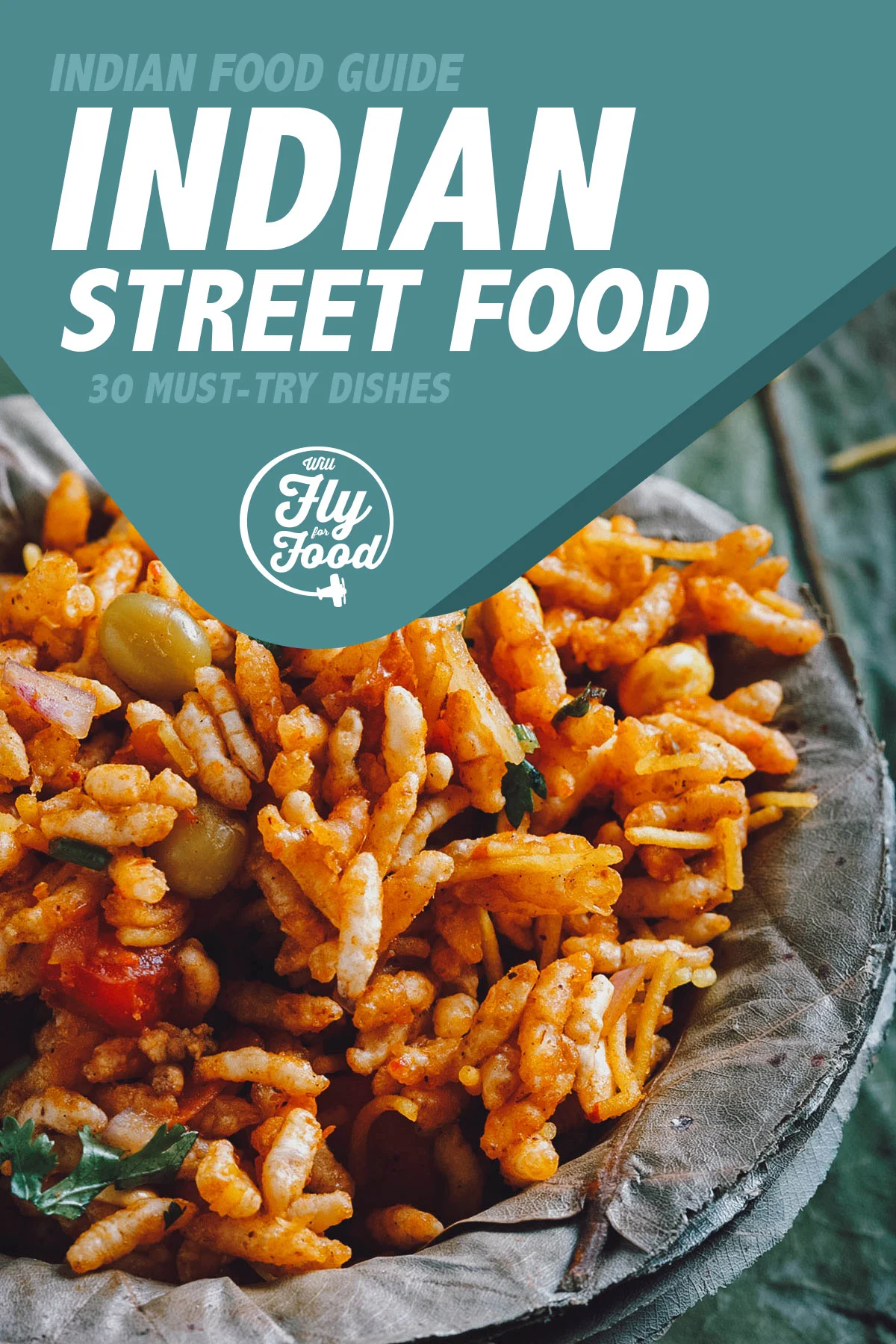
Photo by manubahuguna via Depositphotos
THE BEST INDIAN STREET FOODS
WHAT IS INDIAN STREET FOOD?
In some countries like Japan, street food is limited. Not so in India. Indian street food is as diverse and plentiful as Indian cuisine. Every region has its own specialties with city vendors offering hundreds if not thousands of different options.
The history of street food in India isn’t well documented, but it’s widely believed that its origins can be traced back to the time when the Mughal emperor Shah Jahan moved his capital from Agra to Delhi. Chaat, the most popular type of Indian street food, was first introduced to Old Delhi during that time. It became popular as a mid-day snack after cooks from Varanasi were invited to set up shop in Delhi by officials of the Mughal Dynasty.
Today, street food has become an important part of Indian culture and has taken root in every part of the country. Its affordability makes it accessible to everyone. Aside from chaat, other popular varieties of Indian street food include kebabs, biryani, korma, and kulfi.
TIPS FOR EATING STREET FOOD IN INDIA
Have you heard of “Delhi belly”? It’s the term for traveler’s diarrhea in india. It’s very much a real thing and something you should be concerned about when eating the street food in India. I was aware of it and tried my best not to catch it, but I still suffered a bout of diarrhea in Mumbai, probably from street vendor ice cream.
As tempting as it is to try every Indian street food dish that catches your eye, it’s best to exercise caution as you don’t want a debilitating case of the runs ruining your trip to India. Here are a few pointers to remember when eating street food in India.
- Look for popular street food stalls. The more customers a stall has, the better and safer it’s food is likely to be.
- Avoid dishes and drinks made with water. Unfiltered water is the main culprit for Delhi belly so avoid anything made with undistilled water like ice cubes, fresh fruit juices, and sauces. The same goes for produce washed in tap water. If you can, find street food stalls that prepare their food using distilled water.
- Fried or grilled dishes are safer. Heat kills bacteria so fried or grilled dishes are typically safer to eat. The same goes for drinks. Hot drinks like chai tea are generally safer because they’re made with boiled water.
- Avoid meat dishes. Stay away from meat dishes if you can because you don’t know how long they’ve been sitting out.
- Go on a street food tour. As a foreigner, it’s difficult to know for sure which street food stalls are safe. For peace of mind, I highly recommend going on a street food tour in India. A knowledgeable guide will take you to the city’s best and safest street food stalls so all you have to worry about is how much you can eat. Check out Get Your Guide for a list of food tours in Delhi, Mumbai, Kolkata, and other cities in India.
30 MUST-TRY INDIAN STREET FOODS & DRINKS
1. Nimbu Masala Soda
I went on a food tour in Mumbai and the first place we went to was a stall selling nimbu masala soda. According to my guide, it was a great way of prepping our stomachs for the many street food dishes we were about to have.
Nimbu masala soda is a carbonated drink made with lemon juice and soda water mixed with chaat masala (a spice mix), cumin, and kala namak (black salt). It’s a tasty and intriguing blend of sweet, sour, spicy, and savory that you’d never expect from a drink.
Nimbu masala soda is popular throughout India where it goes by many names like banta soda, goli soda, goti soda, and fotash jawl. It’s especially popular in North India and Delhi where it’s enjoyed as a summer cooler and referred to as “Delhi’s local drink”.
I had it in Delhi as well on a food tour, but towards the end of our tour, perhaps to aid in digestion.
RECIPE: Masala soda
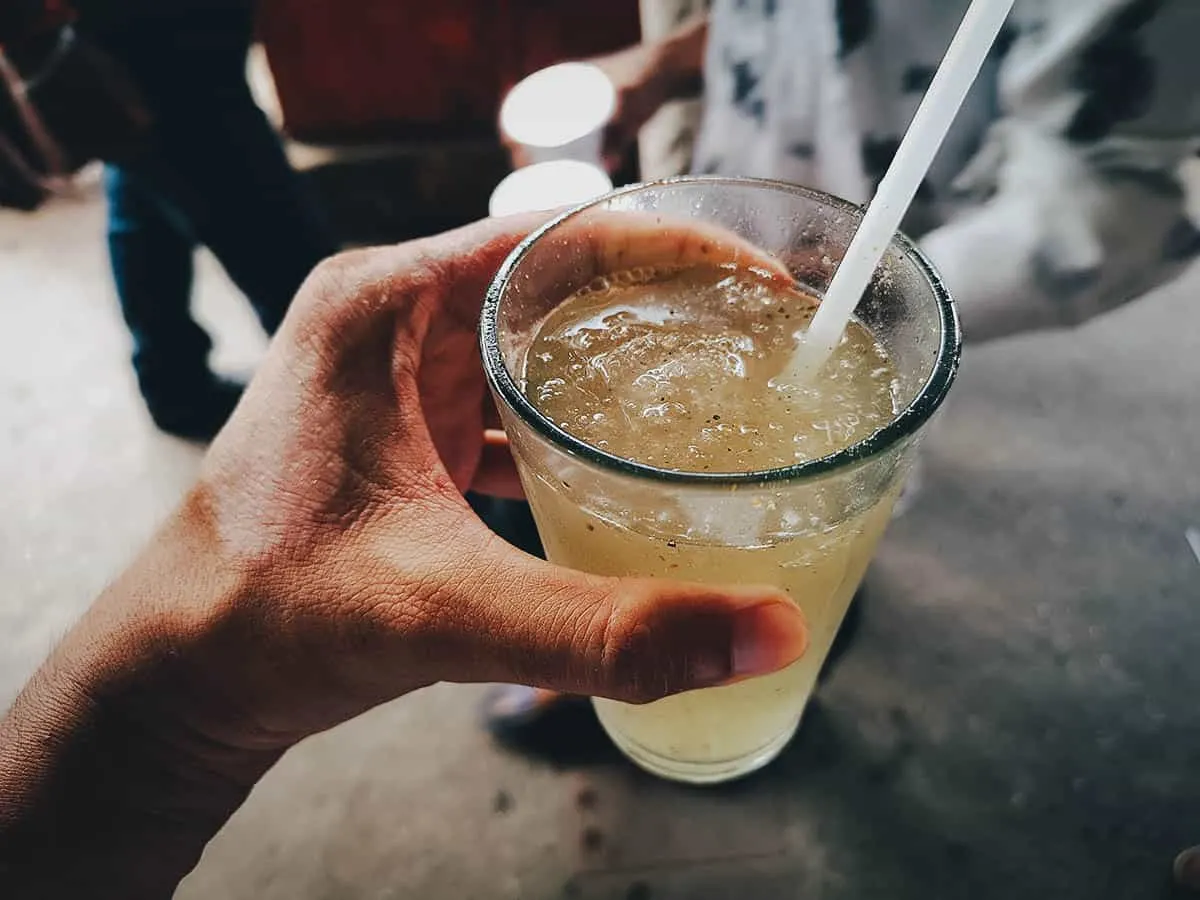
2. Masala Chai
If you’re a frequent customer at Starbucks, then you’ve probably heard of chai tea. Widely consumed throughout India and South Asia, it’s a tea beverage of Indian origin that’s become a staple at cafe and teahouse menus around the world.
Recipes for masala chai vary but it’s typically made by boiling a strong black tea like Assam tea in a buffalo milk and water mixture. It’s brewed with a spice mix called karha which is made using a base of ground ginger and cardamom pods. Depending on the person making it, other spices can be added to the karha mixture like cinnamon, nutmeg, cloves, peppercorn, star anise, and fennel seeds.
Masala chai is a staple drink in Indian households and often sold at roadside stalls throughout the country. When enjoyed at home, it’s usually consumed in the morning with breakfast, or offered to guests as a sign of hospitality. It’s a warming drink that can be enjoyed as is or sweetened with sugar, syrup, honey, or jaggery.
RECIPE: Masala chai
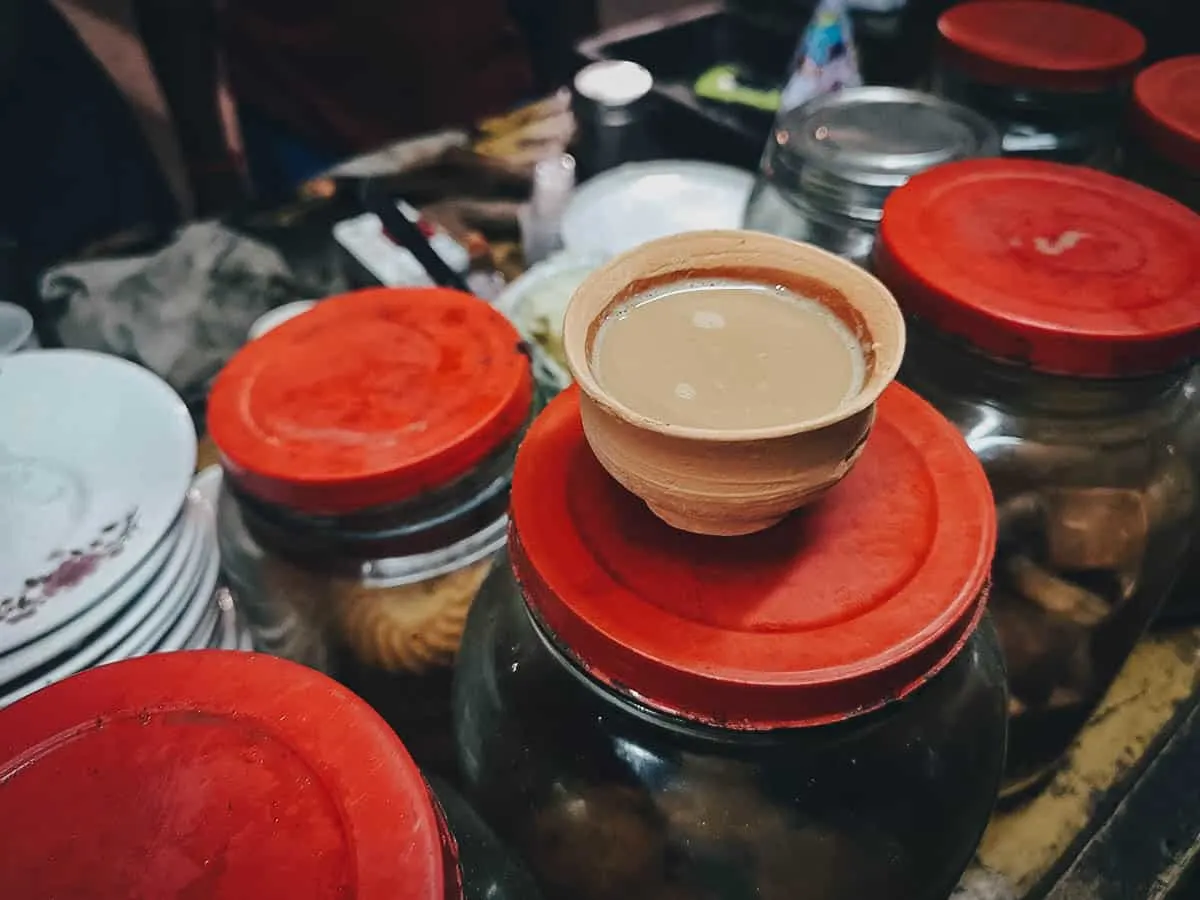
3. Lassi
Other than chai tea, lassi is perhaps the most internationally well-known drink of Indian origin. It refers to a probiotic drink made with a blend of dahi (yogurt), water, and spices.
Lassi is traditionally made with yogurt and water and can be either salty or sweet. Sweet versions of lassi are typically flavored with sugar, rosewater, or different types of blended fruit like mango, lemon, strawberry, and other fruit juices. It’s a refreshingly sweet and tart drink that’s similar in consistency to a milkshake.
Lassi is especially popular in the northern parts of India. Interestingly, some regions like Rajasthan and Gujarat flavor lassi with saffron, while cannabis-infused versions called “bhang” are often consumed during festivals like Holi and Maha Shivaratri. Leaves from the cannabis plant are ground into a paste and mixed into the lassi.
In an India episode of No Reservations, the late great Anthony Bourdain was taken to a licensed bhang shop in Rajasthan where he was offered five types of bhang lassi – baby lassi, medium, normal strong, super duper sexy strong, and “full power, 24 hour, no toilet, no shower”. My man went with the full power. Ha!
Pictured below are traditional lassis served in clay pots. After serving, the clay pots are broken and then recycled to create new pots.
RECIPE: Lassi
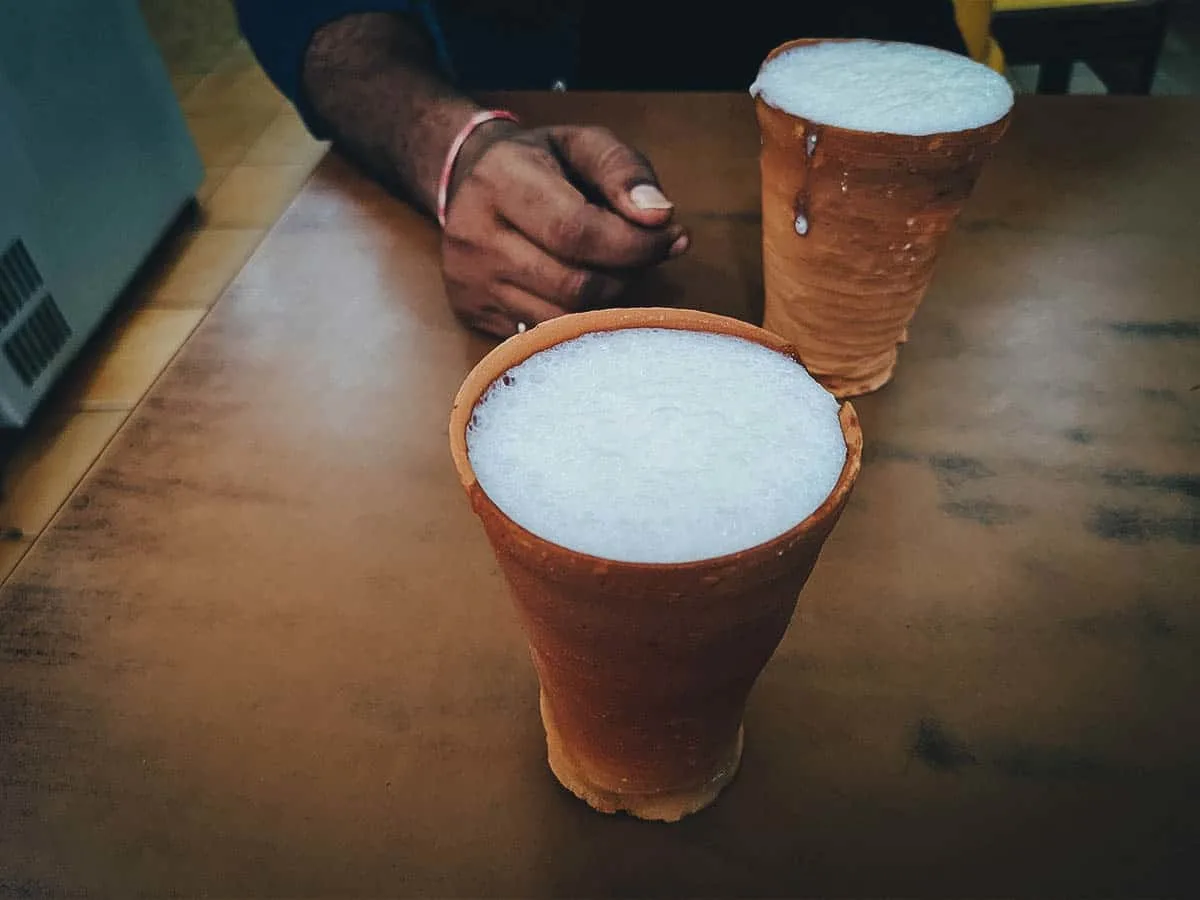
Can you guess what type of lassi this is? It’s a mug of sweet lassi flavored with pomegranate. Not quite super duper sexy strong but very good and highly addictive nonetheless.
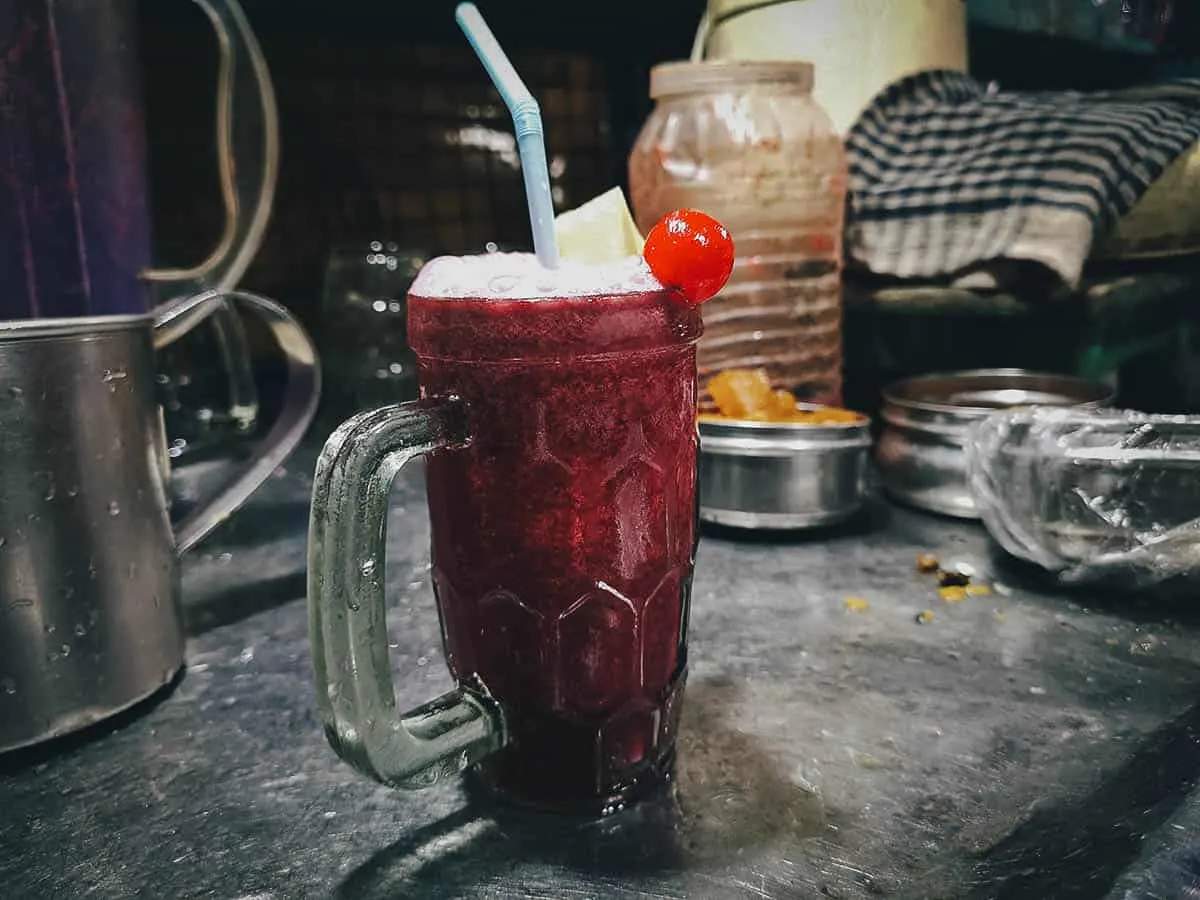
4. Masala Chana Dal Chaat
Chaat is the most popular type of Indian street food. The term refers to a family of savory Indian snacks, some of the most popular being samosas, kachori, dahi vadas, vada pav, and pav bhaji.
To be honest, I find the concept of chaat confusing because the dishes can sometimes look so different. Based on its definition, it refers to Indian street foods made with a crisp starchy base like fried dough or crispy puffed rice. There are many different types of chaat made with a variety of additional ingredients, but the common denominator is the crisp starchy base.
That’s the definition, but I still don’t completely understand it because some dishes that are categorized as chaat don’t seem to fit the description. In any case, I think the concept of chaat – like the side head nod – is something that only locals can fully grasp.
Pictured below is a type of chaat made with chana dal (split baby chickpeas) mixed with chaat masala and other ingredients like peanuts, chopped onion, coriander, and lime. It reminded me of an Indian version of trail mix, but much more interesting and flavorful.
RECIPE: Chana dal chaat
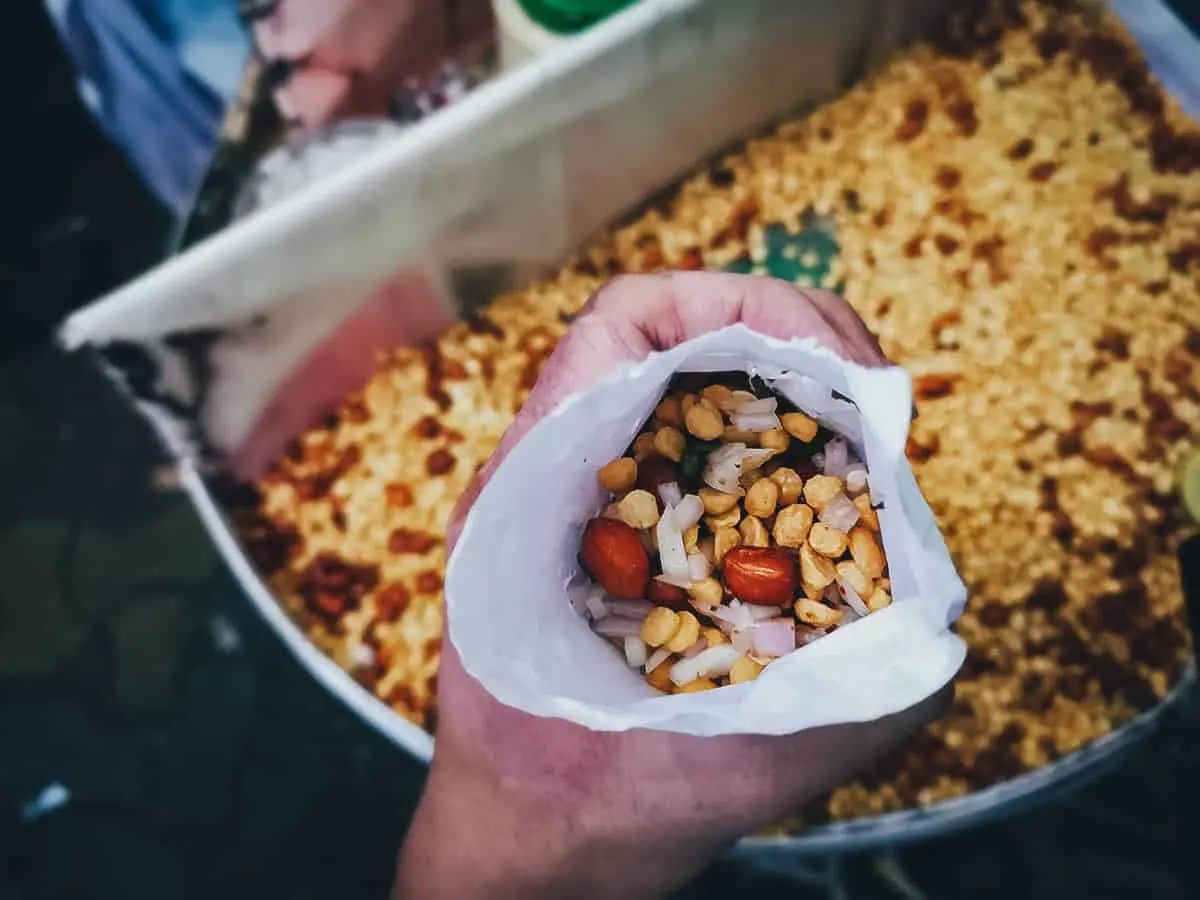
5. Aloo Chana Chaat
Aloo means “potato” so you can probably guess what type of chaat this is by its name. Its made with split baby chickpeas (chana) and fried or boiled potatoes flavored with spices, chutney, and other ingredients. If it’s made with yogurt (dahi), then it’s called dahi aloo chana chaat.
Like the chana dal chaat, it’s a fun Indian street food snack that goes very well with beer. In fact, both of these stalls were located side by side in Kolkata, just outside a liquor store. Location is everything.
RECIPE: Aloo chana chaat
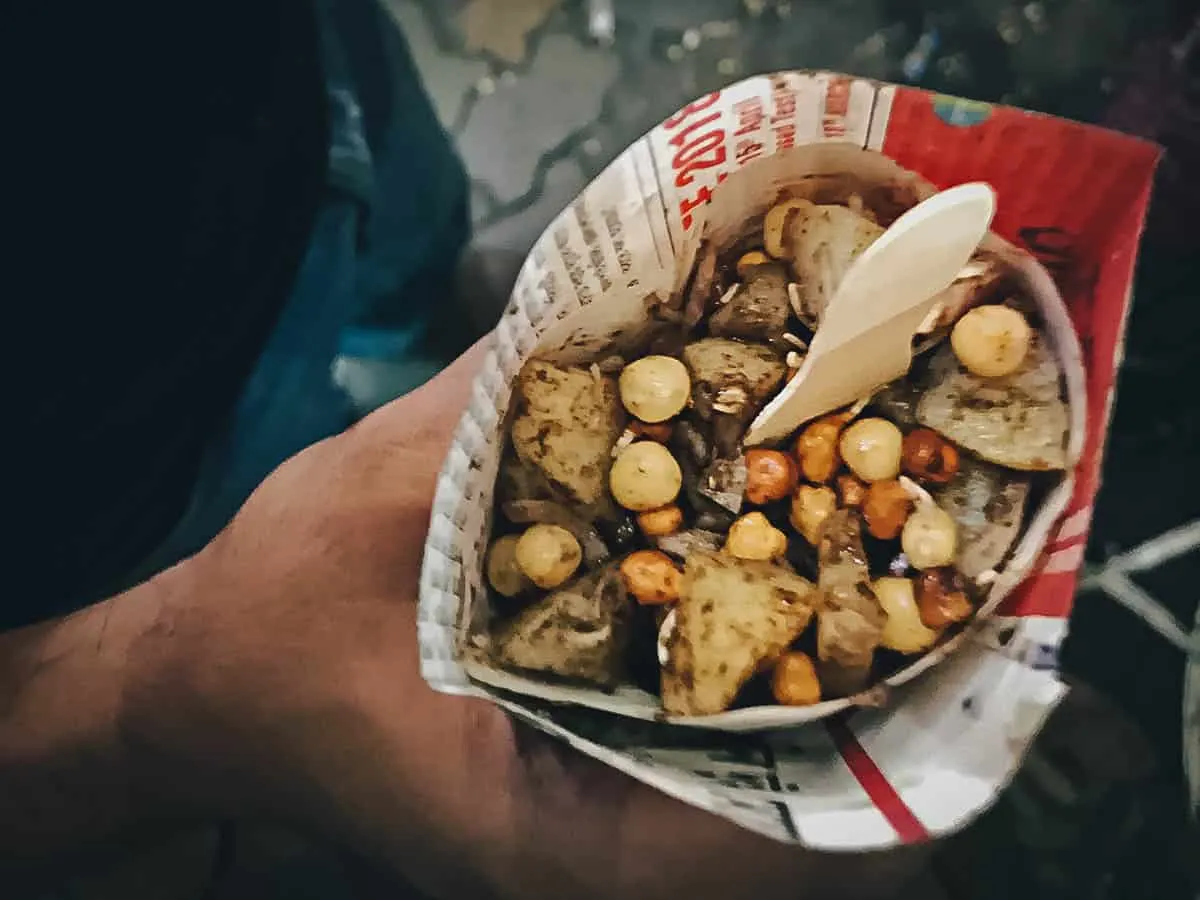
6. Bhel Puri
Bhel puri (or bhelpuri) is a type of chaat made with crunchy puffed rice, sev (fried chickpea noodles), puri, chana dal, vegetables, and spices. It’s strongly associated with the beaches of Mumbai, like Chowpatty, where it’s often enjoyed and referred to as a “beach snack”.
Bhel puri can be served either wet (gaela bhel) or dry (sukha bel). Wet bhel puri is made with the addition of chutneys like tamarind chutney or green coriander chutney, but the base ingredients remain the same. It’s a crunchy and fun snack with an interesting mix of savory, sweet, sour, and spicy flavors.
RECIPE: Bhel puri
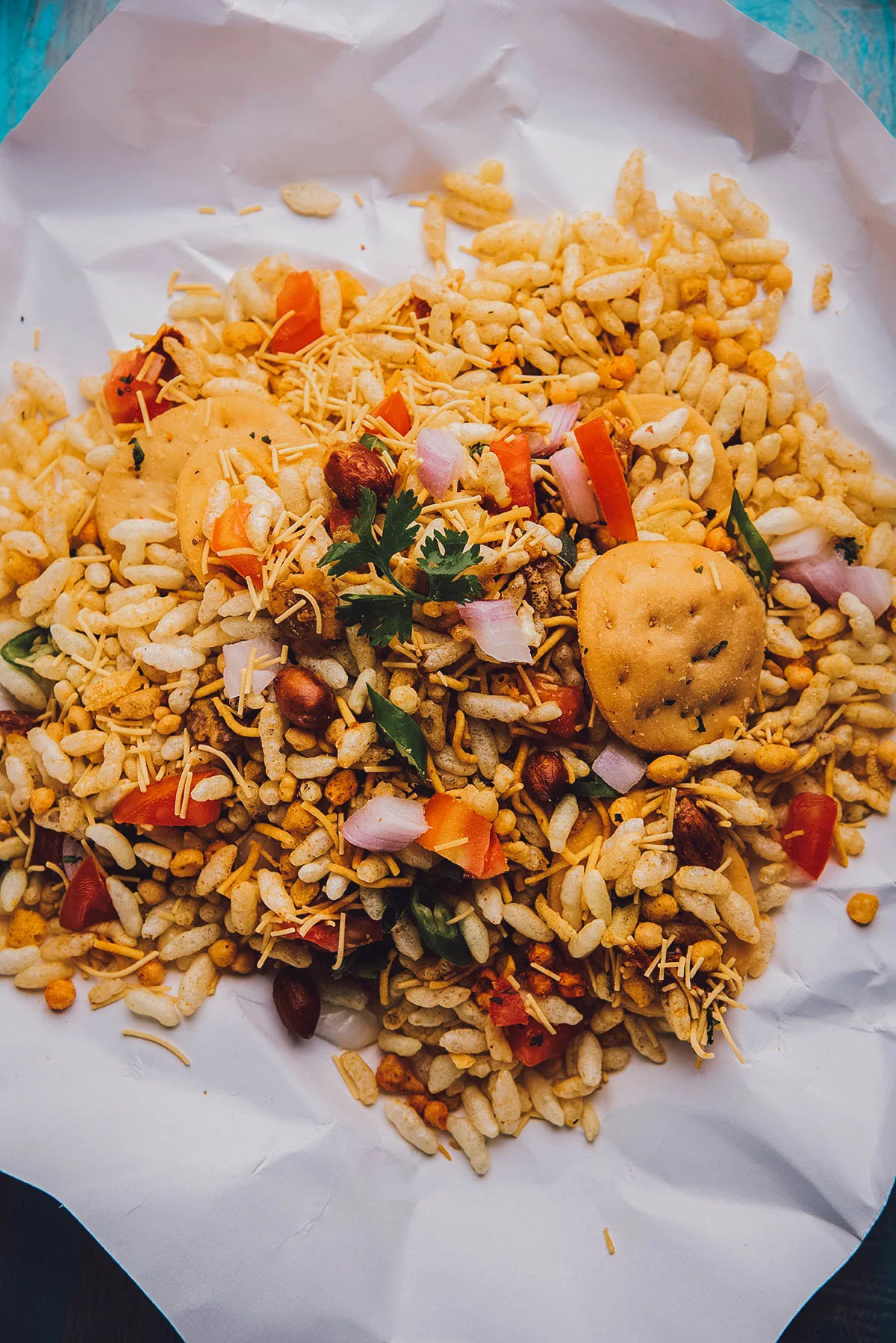
Photo by stockimagefactory.com via Depositphotos
7. Jhalmuri
Jhalmuri is a spicy and tangy version of bhel puri that’s popular in Kolkata and West Bengal. Jhal means “spicy” while muri refers to the puffed rice.
Like bhel puri, jhalmuri is made with puffed rice and a mix of ingredients like sev, roasted peanuts, tomatoes, onions, lemon juice, herbs, and spices. What makes jhalmuri special is the addition of mustard oil which gives the snack its characteristic spicy and pungent flavor.
RECIPE: Jhalmuri
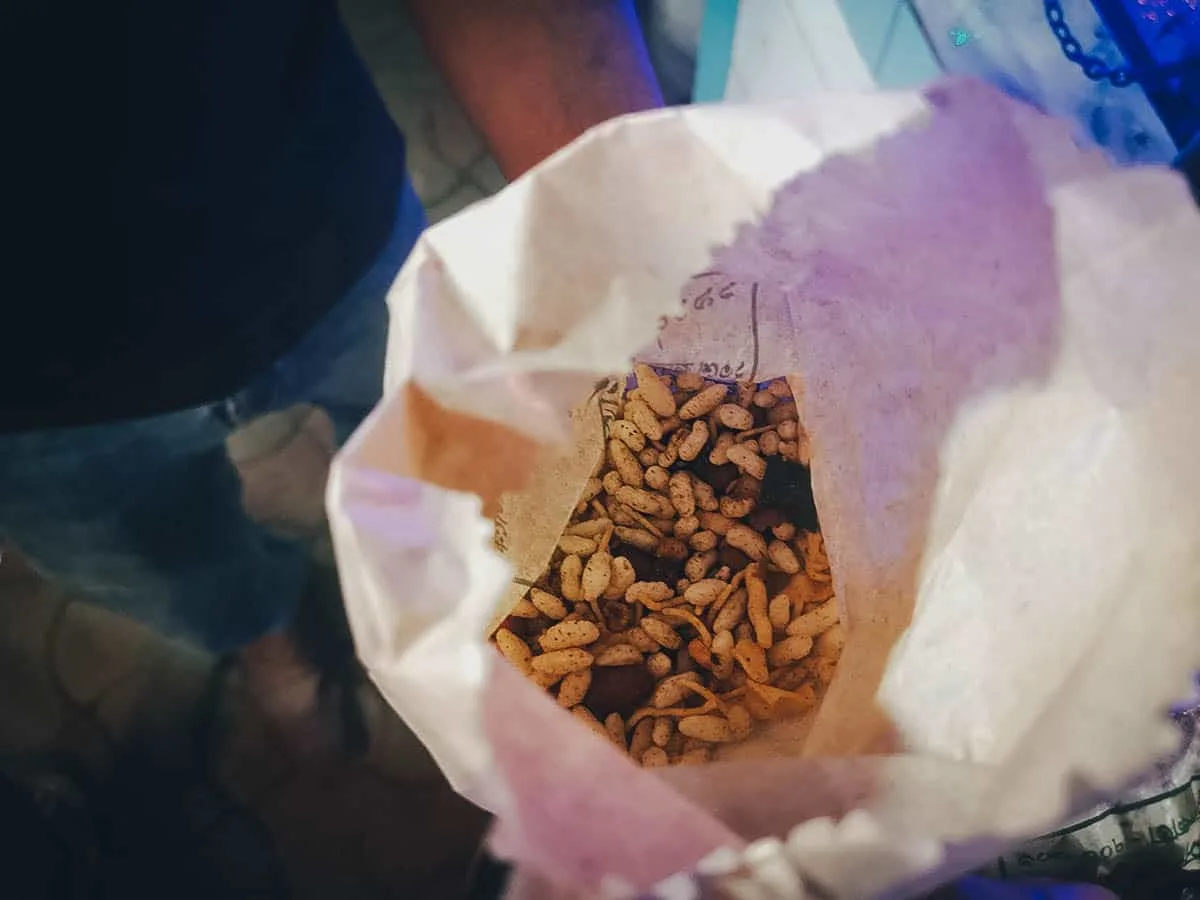
8. Poha
Poha refers to flattened or beaten rice. It can be used to refer to both the ingredient and the Indian dishes made with it. It’s a popular Indian breakfast staple that’s also commonly sold as street food.
To prepare, rice is parboiled and then flattened, resulting in crispy thin flakes that can be consumed with little to no cooking. They can be eaten raw after a bit of soaking or fried and roasted with other ingredients. Poha is popular throughout India where it’s known by many names like avalakki, paunva, poya, pauwa, and aval.
There are many Indian dishes made with poha but one of the most well-known is Indori poha with jalebi. It’s a beloved breakfast and street food dish from Indore made with poha, jalebi, sev, onions, and fennel seeds.
RECIPE: Poha
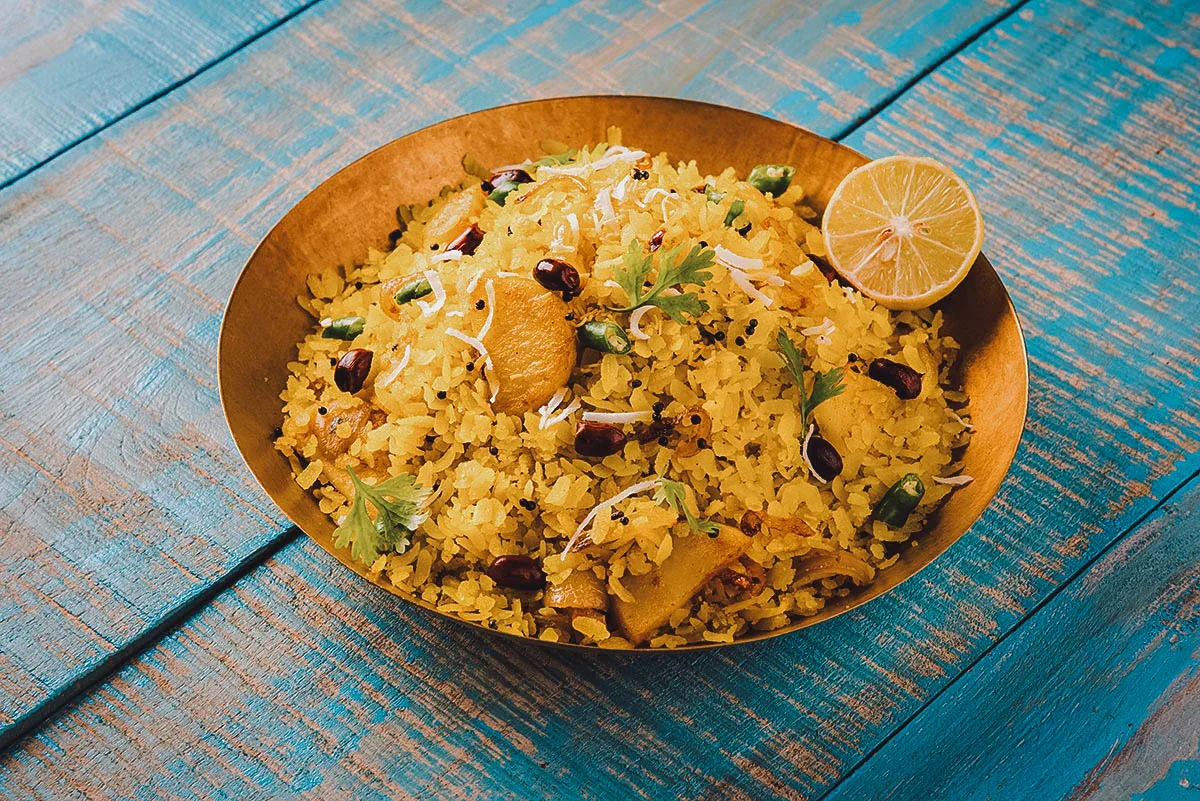
Photo by stockimagefactory.com via Depositphotos
9. Pani Puri / Puchka / Gol Gappa
Pani puri is one of the most interesting street foods I had in India. It refers to a popular type of chaat made with crispy hollow balls called puri. Preparations vary by region but they’re typically filled with a mixture of flavored water, tamarind chutney, mint chutney, chaat masala, green chili, onions, chickpeas, and potato mash. It’s popular throughout India where it goes by different names like puchka, gol gappa, fulki, pakodi, and gup chup.
Aside from its interesting mix of sweet, spicy, and sour flavors, what make pani puri so interesting is how it’s prepared. The top of the puri is punctured and filled with the spice mixture before the whole thing is dunked in tamarind water. The puri is delicate, like a potato chip, so you’re instructed to eat the pani puri whole before it disintegrates. The vendor will keep filling puri arter puri until you tell him to stop.
According to my guides, pani puri is especially popular with Indian women, many of whom are known to consume over twenty pani puris in one sitting. They’re like little flavor bombs on your taste buds and something that you absolutely need to try in India.
With that said, be careful where you eat pani puri because they’re made with water. For that reason, I recommend trying them on a food tour.
RECIPE: Pani puri
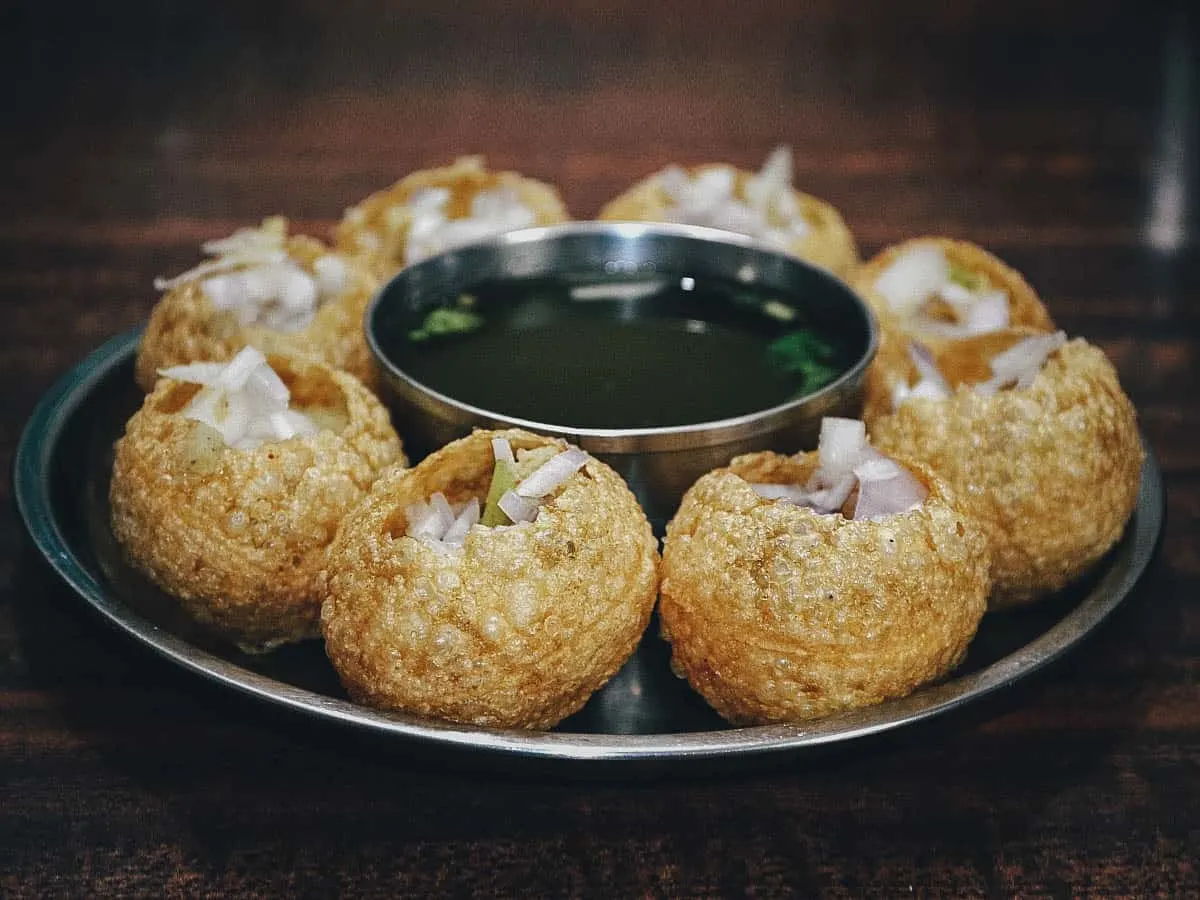
Rupamdas75, CC BY-SA 4.0, via Wikimedia Commons
10. Dahi Vada
Dahi vada is a type of chaat made by soaking vadas in a thick yogurt sauce. Vadas are soft lentil fritters while dahi refers to yogurt, so the name dahi vadas literally means “fritters soaked in yogurt”. It’s a popular Indian festival dish that’s also commonly sold as street food.
To prepare, urad lentils are soaked overnight and ground into a batter before being deep-fried. They’re then soaked in water and drained before being covered in a thick beaten yogurt sauce. Before serving, they’re usually topped with green coriander chutney, tamarind chutney, and a host of spices and garnishes like cumin, chili powder, chaat masala, and pomegranate seeds. Creamy, tangy, and sweet, the vadas have an interesting texture that’s similar to soft fluffy donuts.
Like many of the dishes in this Indian street food guide, dahi vada is popular throughout the country where it goes by different names like dahi bhalla, dahi bade, thayir vadai, doi bora, and thairu vada.
RECIPE: Dahi vada
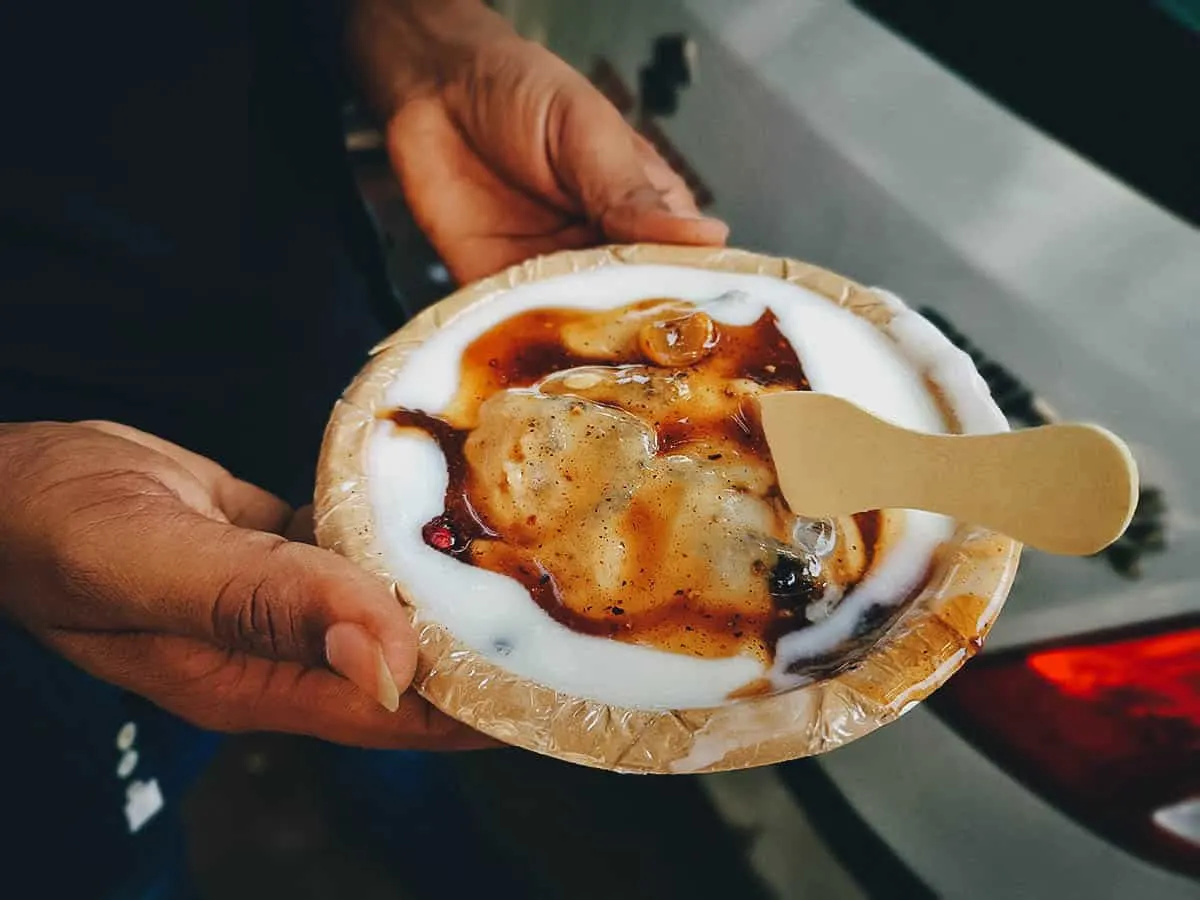
11. Kanji Vada
Kanji vada is a traditional Rajasthani street food dish made with vadas soaked in mustard-flavored fermented water called kanji or rai ka paani. The vadas are made from a combination of moong dal and urad dal flavored with green chili peppers, ginger, and salt. The vadas are left to soak in the kanji for several minutes before serving to absorb its mustardy flavor.
During the Holi festival, a special type of kanji vadas is prepared using chakundar kanji. Chakundar kanji is a type of kanji made with fermented beetroot and carrots that give the liquid a rich red color.
RECIPE: Kanji vada
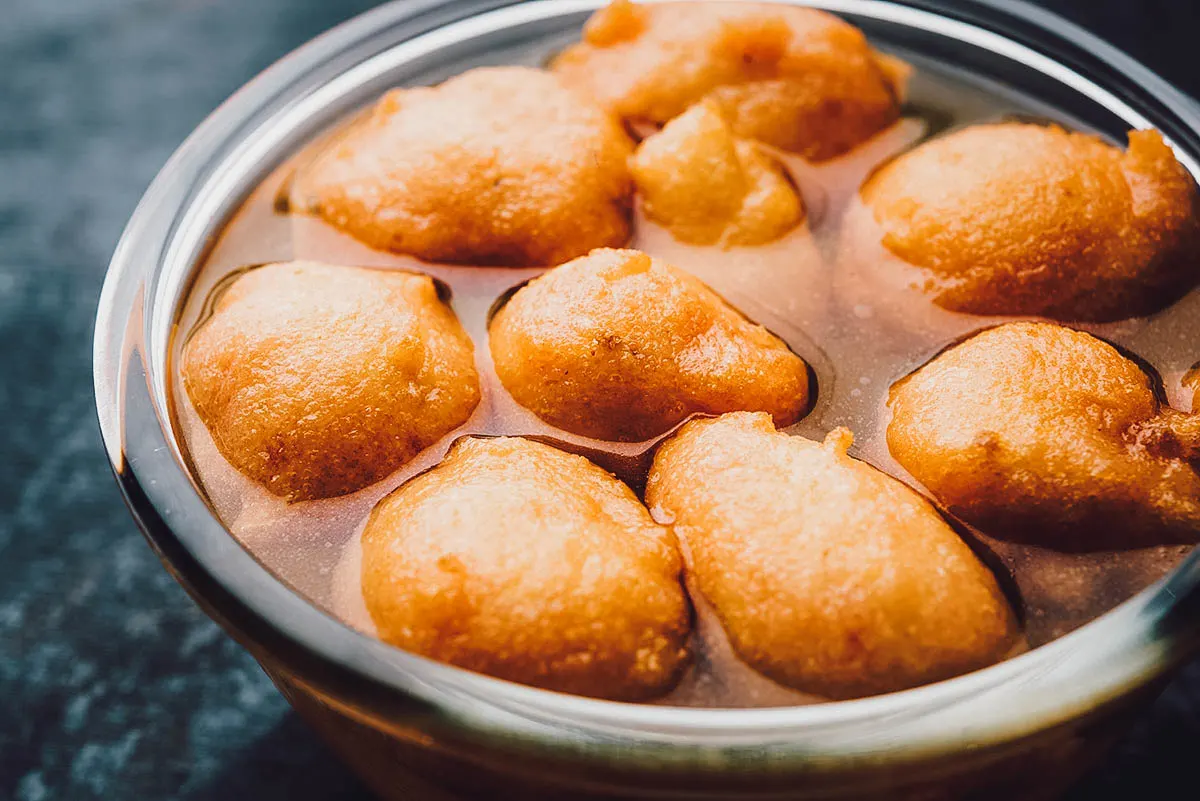
Photo by [email protected] via Depositphotos
12. Kachori
Kachori is a type of chaat made with deep-fried breads. It’s popular throughout India where it goes by many names like kachauri, katchuri, and kachodi.
You can’t tell from this picture but the kachori itself is shaped like a round flattened ball (similar to aloo tikki) filled with a stuffing. Depending on where it’s from, fillings can vary but common stuffing ingredients include yellow moong dal, urad dal, besan (gram flour), black pepper, chili powder, cumin, and other spices. From what I understand, kachori is usually savory but it can also be sweet.
Kachori can be eaten on its own or in this case, drenched in gravy. I had this version from a stall in Chandni Chowk that was smothered in aloo ki sabzi, which is a type of spicy potato curry. According to my guide, this stall is known for serving some of the best kachori in Delhi.
RECIPE: Khasta kachori
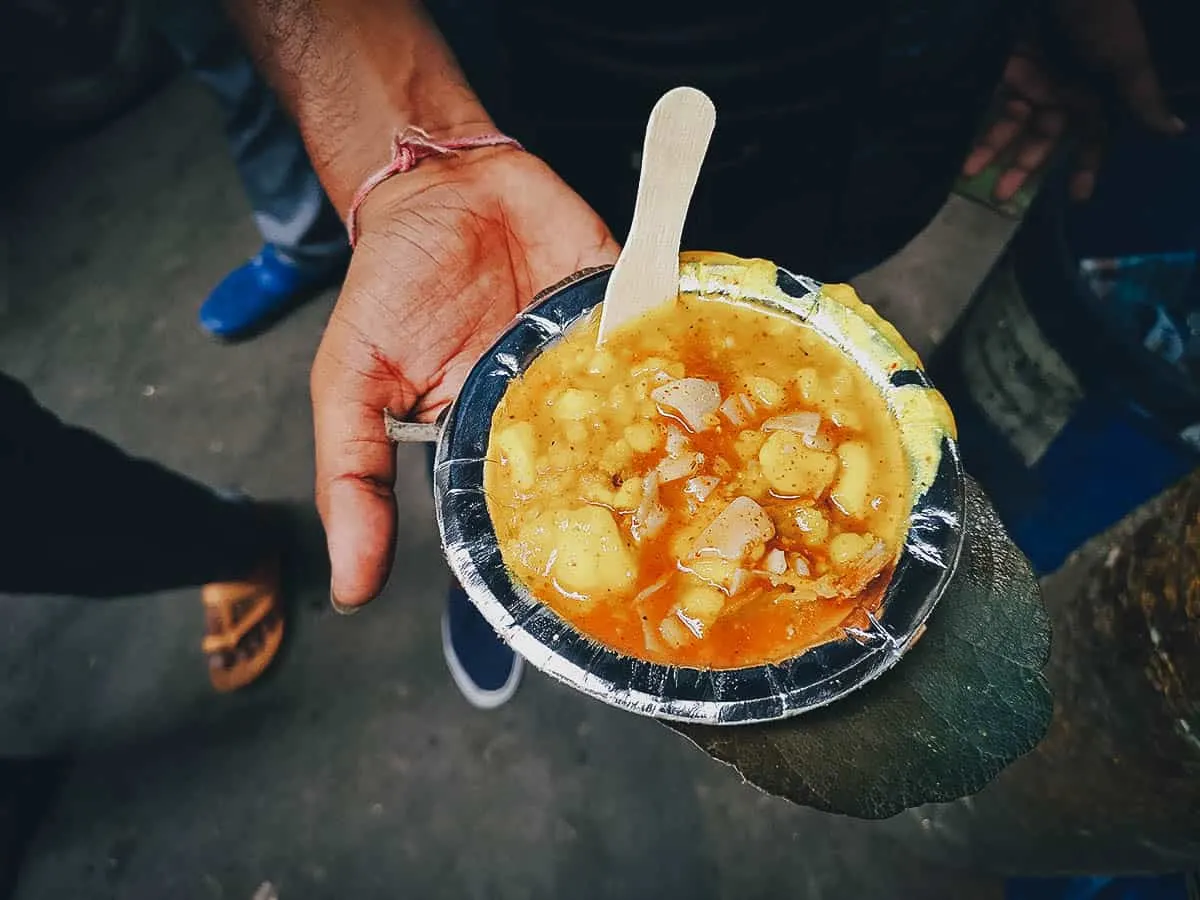
13. Aloo Tikki
Aloo tikki is a type of Indian fritter made with deep-fried mashed potatoes. Aloo means “potato” while tikki refers to a small cutlet or croquette. You can think of aloo tikki as the Indian version of hash browns.
Aloo tikki can be made with or without a stuffing. To prepare, boiled potatoes are mashed and formed into patties before being filled with ingredients like coriander, peas, chana dal, and different herbs and spices. The patties are then deep-fried and served with a sauce like tamarind chutney, green coriander chutney, tomato chutney, or dahi.
RECIPE: Aloo tikki
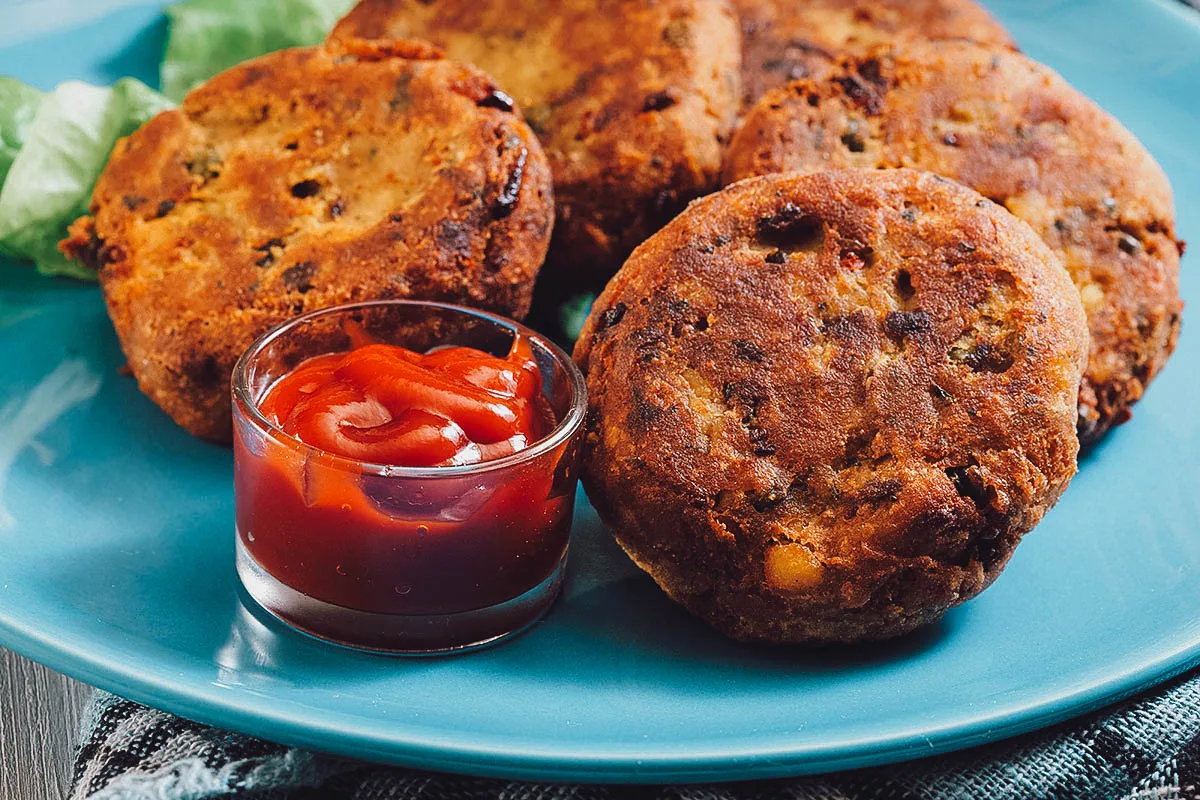
Photo by fotek via Depositphotos
14. Samosa
Samosa is one of the most popular dishes in Indian cuisine. It’s widely available throughout India as street food or as an appetizer or snack at restaurants, cafes, and gatherings.
Samosa refers to a pastry filled with savory ingredients like potatoes, peas, onions, lentils, meat, herbs, and spices. It’s often shaped like a triangle or pyramid but it can take other forms as well depending on where it’s made. Samosas can be baked or fried and often served with tamarind chutney or green coriander chutney.
I’ve always associated samosas with Indian cuisine so it was interesting to learn that it may not be an Indian dish after all, at least not originally. It’s believed to have originated in the Middle East sometime in the 10th century and was brought to India by merchants who enjoyed it as an easy on-the-go snack. It’s earliest mention was in the Iranian history book Tarikh-i Bayhaqi, where it was referred to as “sambosa”.
Samosa may not be Indian in origin but it’s very much a part of Indian cuisine now. It’s also popular in other parts of South Asia, the Middle East, Southeast Asia, Western Asia, the Mediterranean, and Africa.
RECIPE: Punjabi samosa
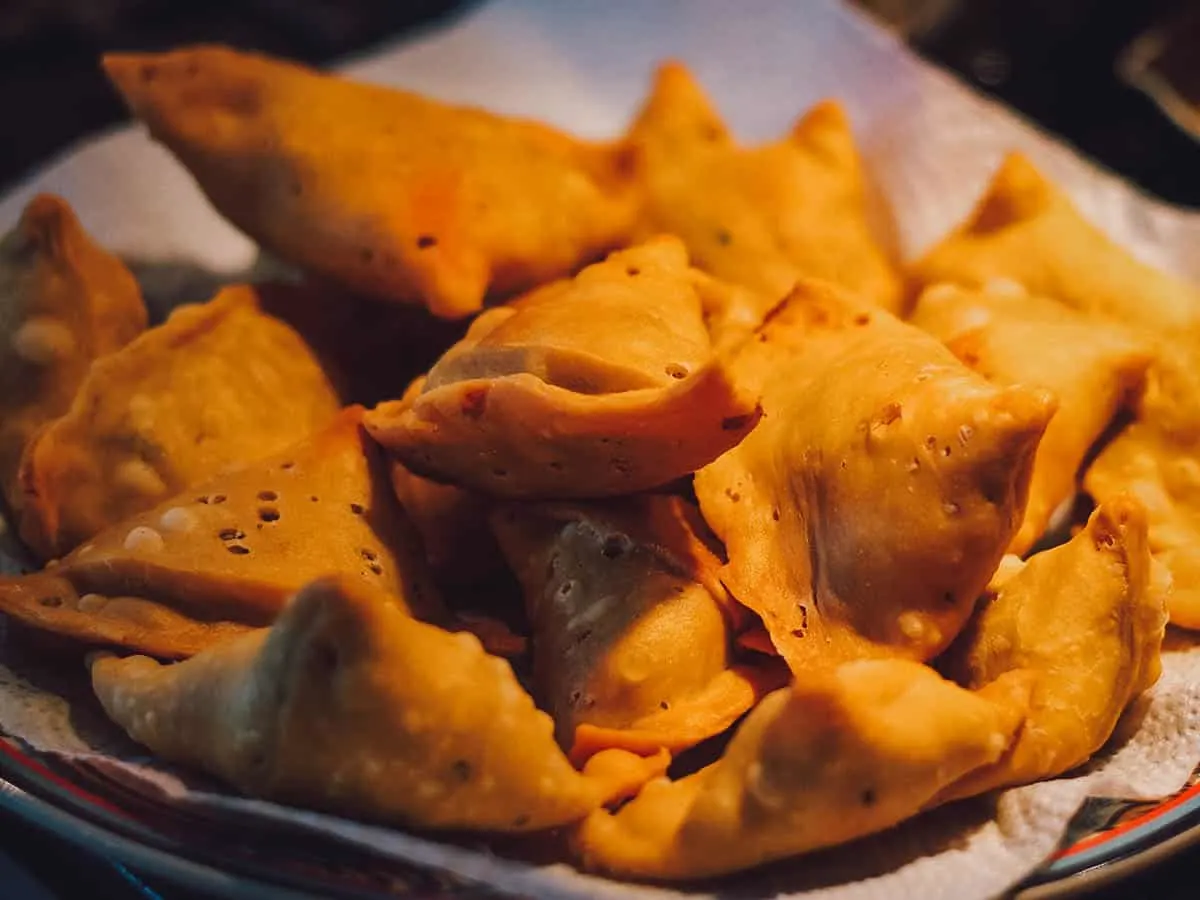
“Samosa” by Avinash Bhat, used under CC BY-SA 2.0 / Processed in Photoshop and Lightroom
15. Pakora
Pakora refers to a type of spiced fritter made with a variety of ingredients, usually vegetables, coated in seasoned gram flour batter and then deep-fried. They’re usually eaten as a snack or appetizer with tamarind sauce, chutney, or raita.
Some of the most common ingredients used to make pakoras include onions, potatoes, plantains, paneer (Indian cottage cheese), and green chilies, though they can be made with animal proteins like meat and fish as well.
Enjoyed in countries throughout South Asia like India, Pakistan, Sri Lanka, Nepal, and Bangladesh, it’s a tasty and crunchy snack that goes by different names like bhajia, bhaji, pakoda, or bora.
RECIPE: Pakora
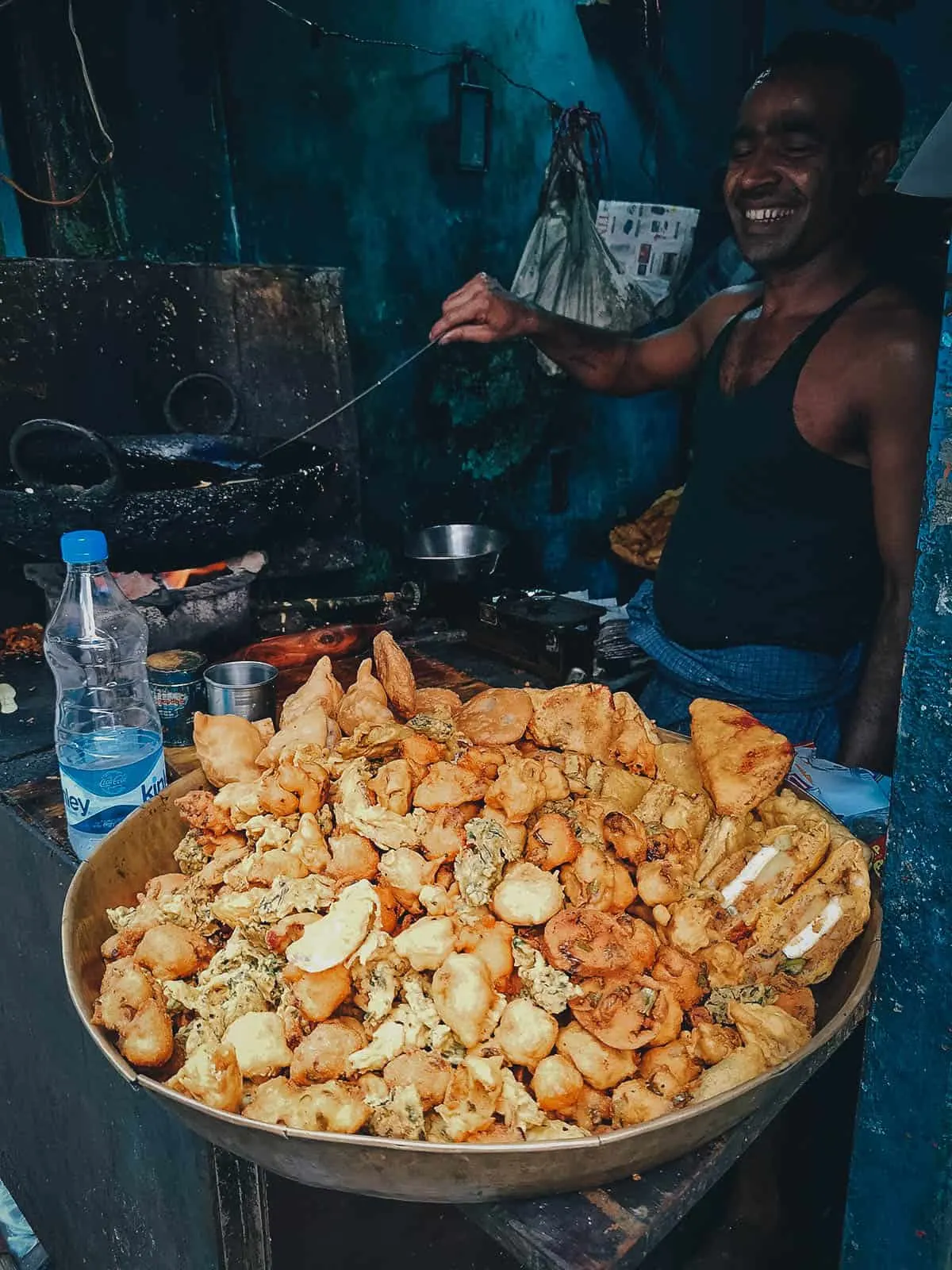
Pictured below is kanda bhaji, a regional variant of pakora made with deep-fried onions. It’s like the Indian version of an onion ring loaf. So good!
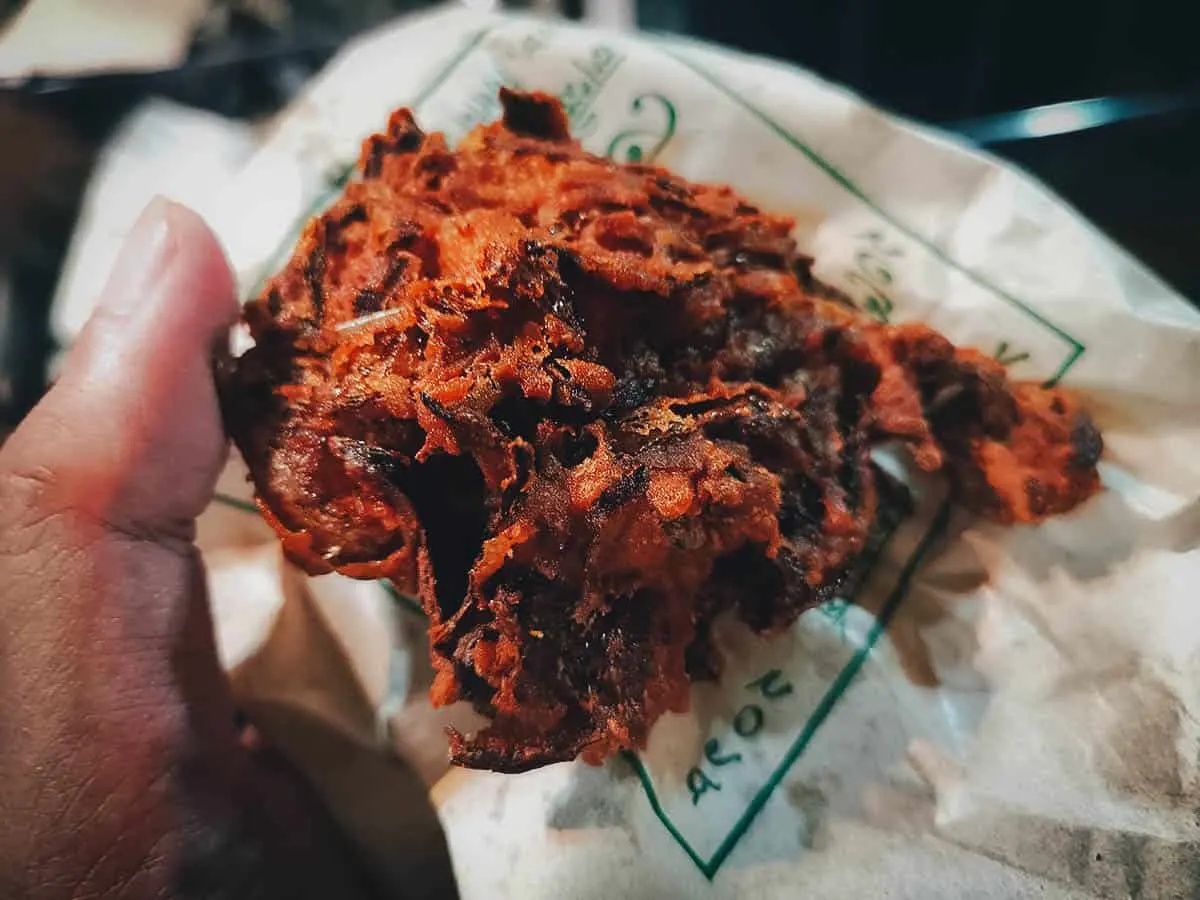
16. Dosa
Dosas are thin rice and lentil crepes made from ground and fermented lentil-rice batter. It’s become popular throughout the Indian subcontinent but it’s a well-known South Indian dish that’s commonly eaten for breakfast or as a snack.
To prepare, lentils and rice are soaked for several hours before being ground separately to a fine consistency. They’re then seasoned with salt and allowed to ferment overnight. When ready, the batter is poured onto a cast-iron pan or skillet and cooked like a crepe till golden brown and crispy.
There are many types of dosa. They can be eaten plain or stuffed with a filling made from vegetables, potatoes, and spices. Pictured below is one of the most common types of dosa called masala dosa. It’s made with potato masala and served with different sides like chutney and sambar (lentil-based vegetable curry).
RECIPE: Dosa
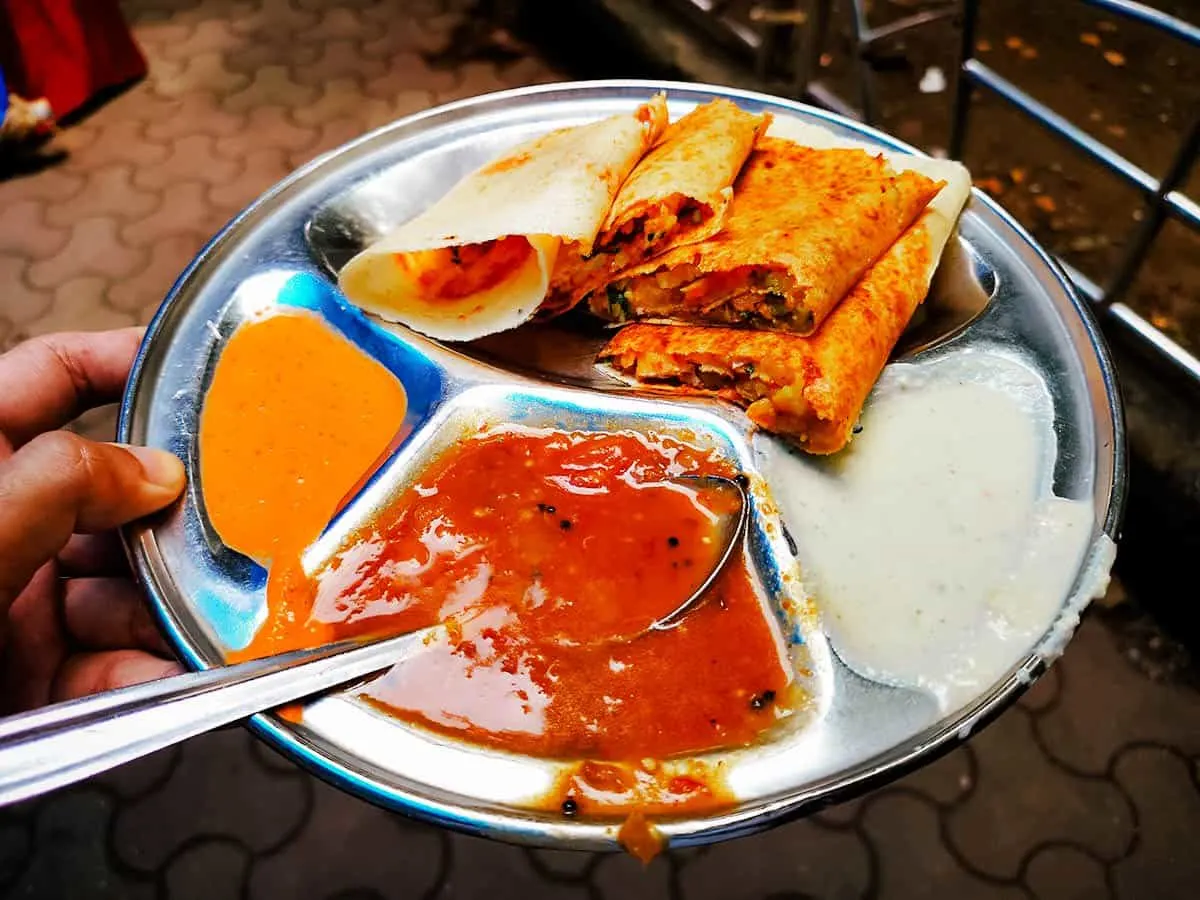
17. Paratha
Paratha is a crisp and chewy Indian flatbread made with whole wheat flour. It’s popular throughout the Indian subcontinent where it’s typically eaten for breakfast or as a snack with various side dishes like chutneys, yogurt, and pickled vegetables.
The process for making parathas is similar to laminated dough. Whole wheat dough is rolled and folded multiple times while being layered with ghee before being pan-fried. It can be served plain of filled with various ingredients like potato, vegetables, and paneer.
Unlike other types of Indian flatbread like roti or naan which are typically consumed as a side dish to curries, paratha is often enjoyed as a standalone dish.
RECIPE: Paratha
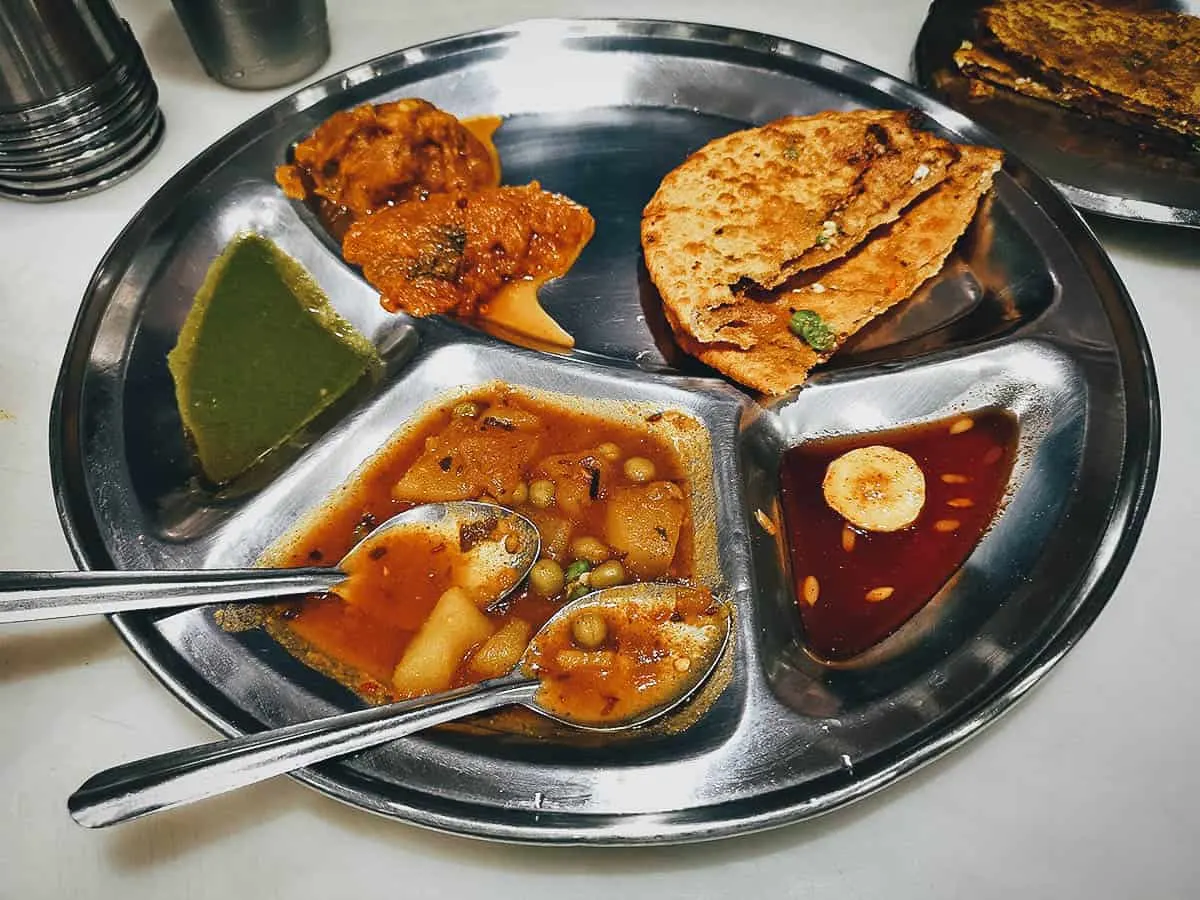
18. Pav Bhaji
Pav bhaji was one of my favorite street foods in India. It’s a simple dish but it’s comforting and absolutely delicious.
Pav bhaji is originally from Mumbai where it was invented as a quick lunchtime dish for the city’s textile mill workers in the 1850s. The dish caught on and started appearing on restaurant menus in Mumbai and throughout the country.
Pav bhaji consists of a thick spiced curry made with potatoes and vegetables like onions, peas, bell peppers, and tomatoes. The potatoes and vegetables are cooked with spices before being mashed and served with a soft buttery bread roll. Pav means “bread roll” while bhaji refers to vegetables or vegetable-based dishes.
Together with vada pav, pav bhaji is one of the most popular street foods in Mumbai. I suggest trying it at Chowpatty or Juhu Beach. It’s the perfect dish to snack on while enjoying the view of the ocean.
RECIPE: Pav bhaji
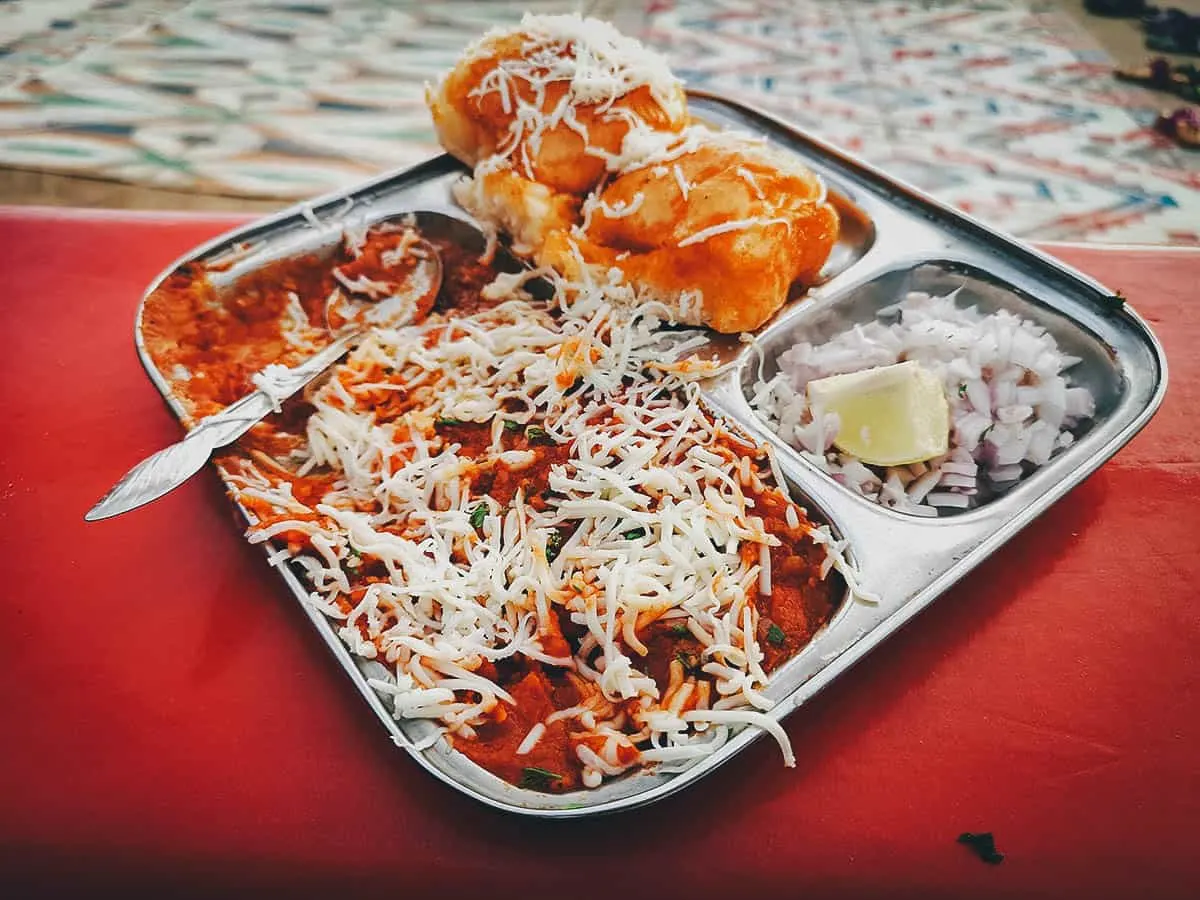
19. Bombay Sandwich
As you can probably guess from the name, the Bombay sandwich is a popular street food sandwich in Mumbai. It’s a vegetarian sandwich made with beetroot, boiled potatoes, onions, tomatoes, bell peppers, cucumbers, chaat masala, and mint chutney sandwiched between buttered slices of white bread.
Bombay sandwiches can be made with plain or toasted bread. The beautiful specimen pictured below was made by inserting the sandwich in a metal clamp and grilling it over charcoal. It was then cut into portions and drizzled with ketchup before serving. Delicious!
RECIPE: Bombay sandwich
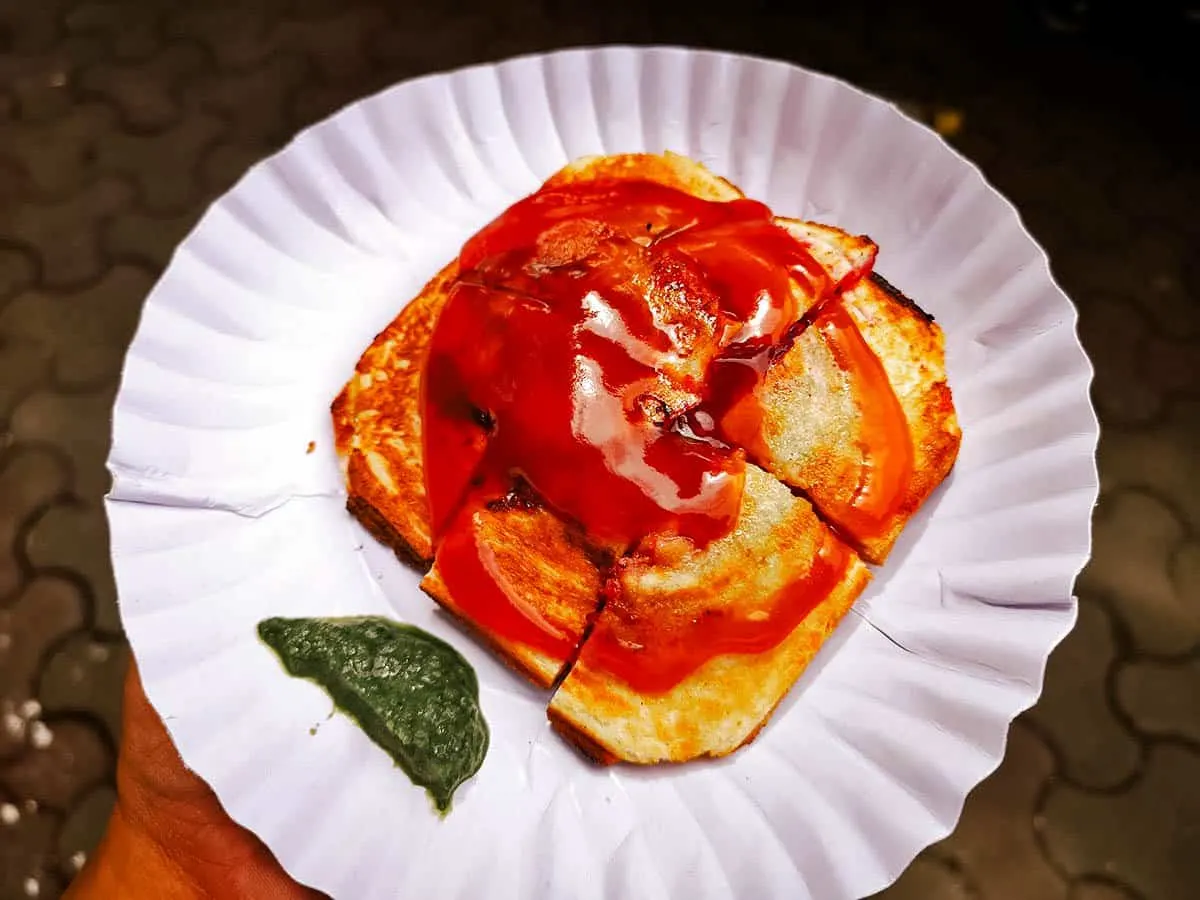
20. Vada Pav
Like pav bhaji, vada pav is one of the most popular street foods in Mumbai. You can think of it as an Indian vegetarian slider made with deep-fried mashed potato fritters (batata vada) served in a soft bread roll.
To prepare, boiled potatoes are mashed and mixed with garlic, green chili peppers, mustard seeds, and spices. The seasoned mash is then shaped into a ball and dipped in besan flour before being deep-fried and served in a bread roll with fried green chilies and one or more chutneys (garlic chutney, mint chutney, tomato chutney, etc).
Most vada pav sandwiches seem to be made with one large batata vada or potato dumpling. This version from a hugely popular stall in Mumbai was made with smaller potato fritters for more texture and crunch.
RECIPE: Vada pav
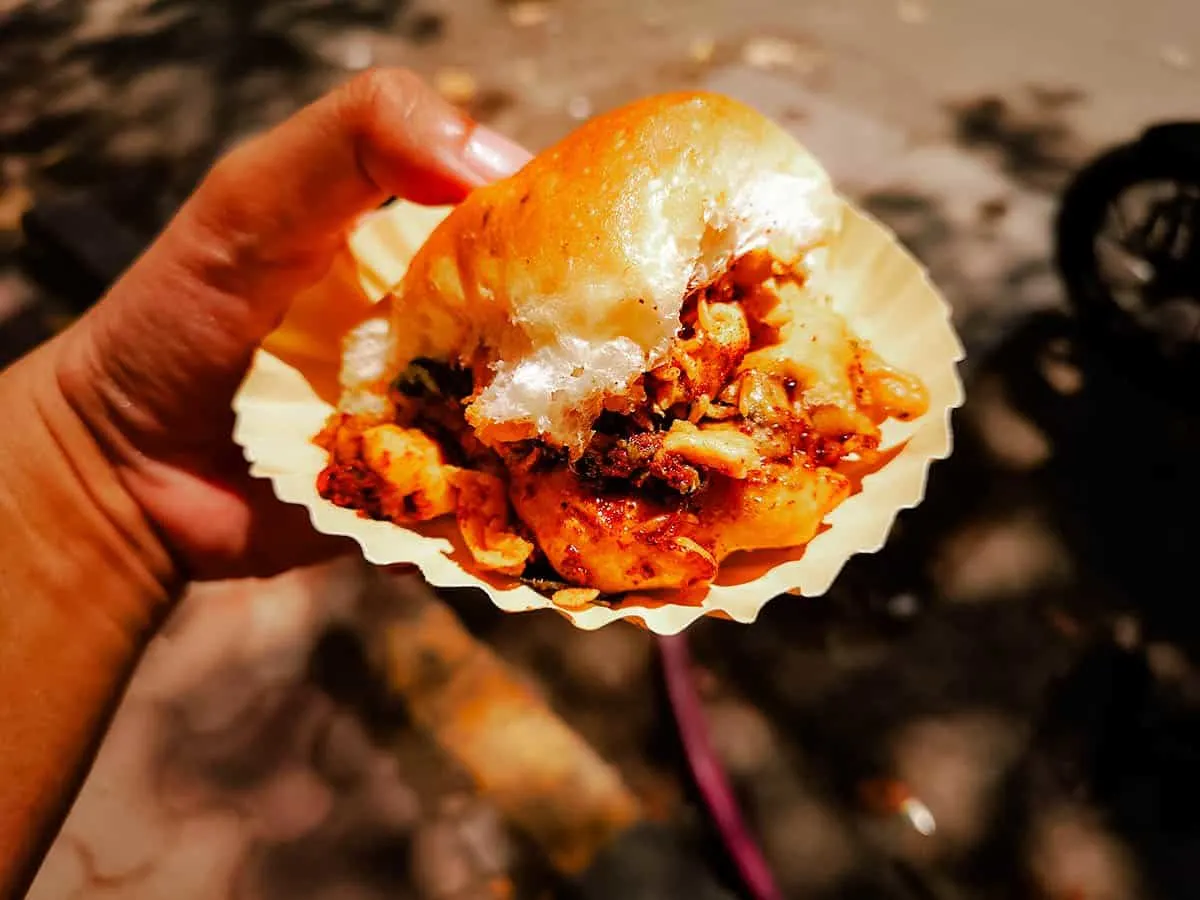
21. Dabeli
Originally from the Kutch region of Gujarat, dabeli is a type of Indian sandwich that looks similar to vada pav. But unlike vada pav which is savory, dabeli is more sweet and tangy.
Dabeli is made with a spice mixture called dabeli masala which consists of cumin, cloves, coriander seeds, cinnamon, and red chili peppers. It’s mixed into a cooked potato mash and served in a bread roll with grated coconut, coriander, pomegranate seeds, sev, onions, roasted peanuts, and one or more chutneys.
RECIPE: Dabeli
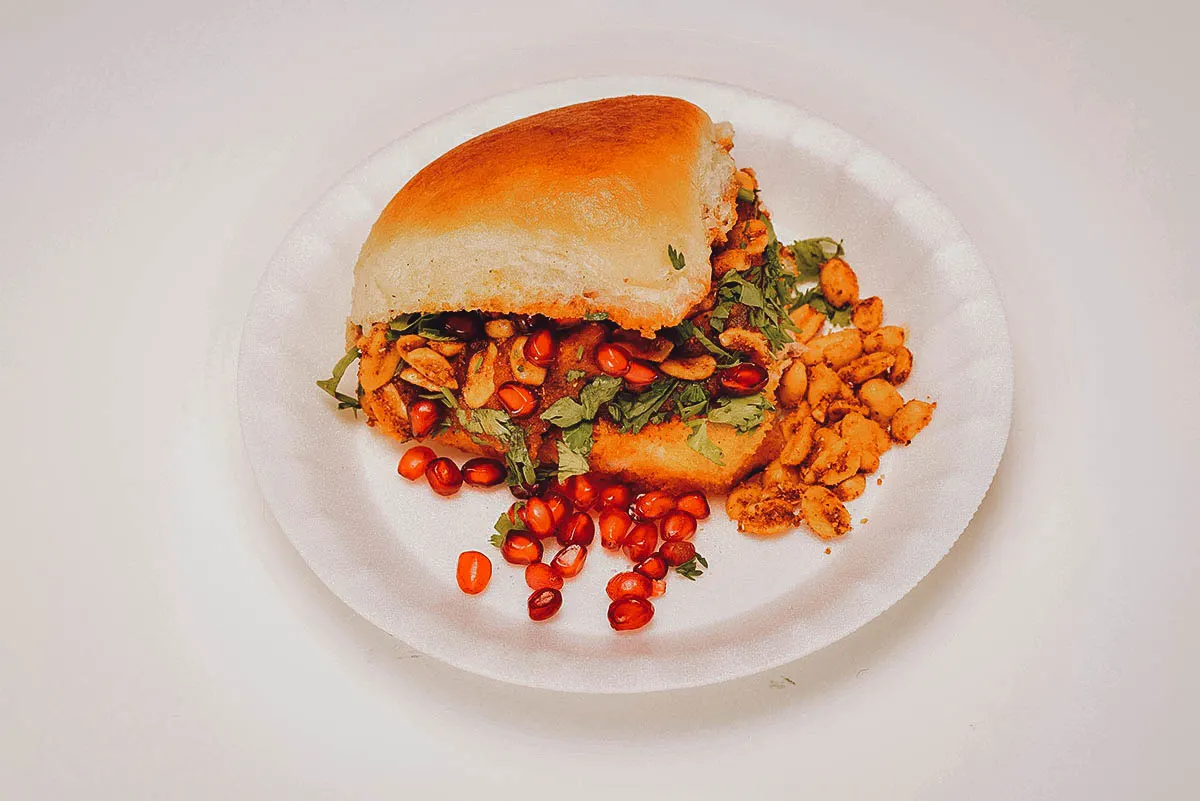
Photo by Priva_Studio via Depositphotos
22. Kathi Roll
The kathi roll (or kati roll) is a type of wrap that was invented and popularized by Nizam’s restaurant in Kolkata. It consists of kebab meat wrapped with various vegetables, egg, and chutney in paratha flatbread.
In its original form, kathi rolls were made only with beef but they’re now made with other proteins as well like chicken tikka, mutton, or even just vegetables. It’s believed that the kathi roll was created to attract British customers. Office commuters didn’t have the time for traditional kebab dishes so the kathi roll was invented as a quick and portable way of consuming kebabs.
Kati in Bengali means “stick” and refers to the bamboo skewer used to cook the kebabs. It’s an incredibly tasty wrap that’s easy to eat on the go.
Pictured below is the lip-smackingly delicious chicken tikka kathi roll from Kusum Rolls in Kolkata. It’s a bit oily on the hands but a real joy to the taste buds. Be sure to try their egg rolls and mutton rolls as well.
RECIPE: Kathi roll
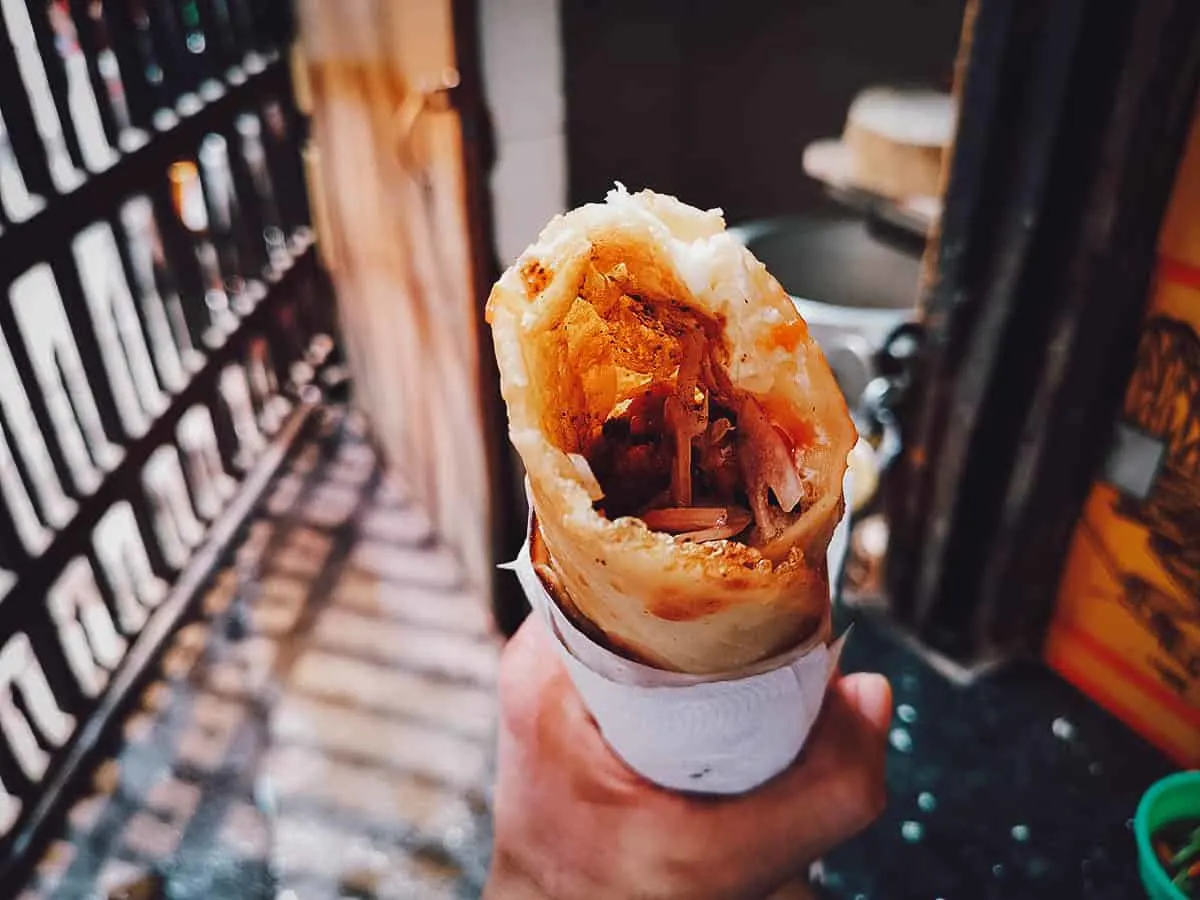
23. Kebab
The kebab is a hugely popular dish that’s consumed in many parts of the world, including India. It refers to grilled meat dishes skewered on metal or bamboo sticks. Traditionally, they’re made with mutton or lamb but they can be made with other proteins as well like chicken, beef, goat, and fish.
In India, the origin of modern-day kebabs can be traced back to the kitchens of the Mughal Empire. Indian kebabs can be made with skewered cubed meat (shish kebab) or ground meat (seekh kebab) that’s heavily seasoned with Indian spices.
One of the most well-known types of Indian kebab is the tunde ke kabab or buffalo meat galouti kebab from Lucknow. I don’t know how true this is, but the original version of this buffalo meat kebab was said to have been made with a staggering 160 spices.
RECIPE: Seekh kebab
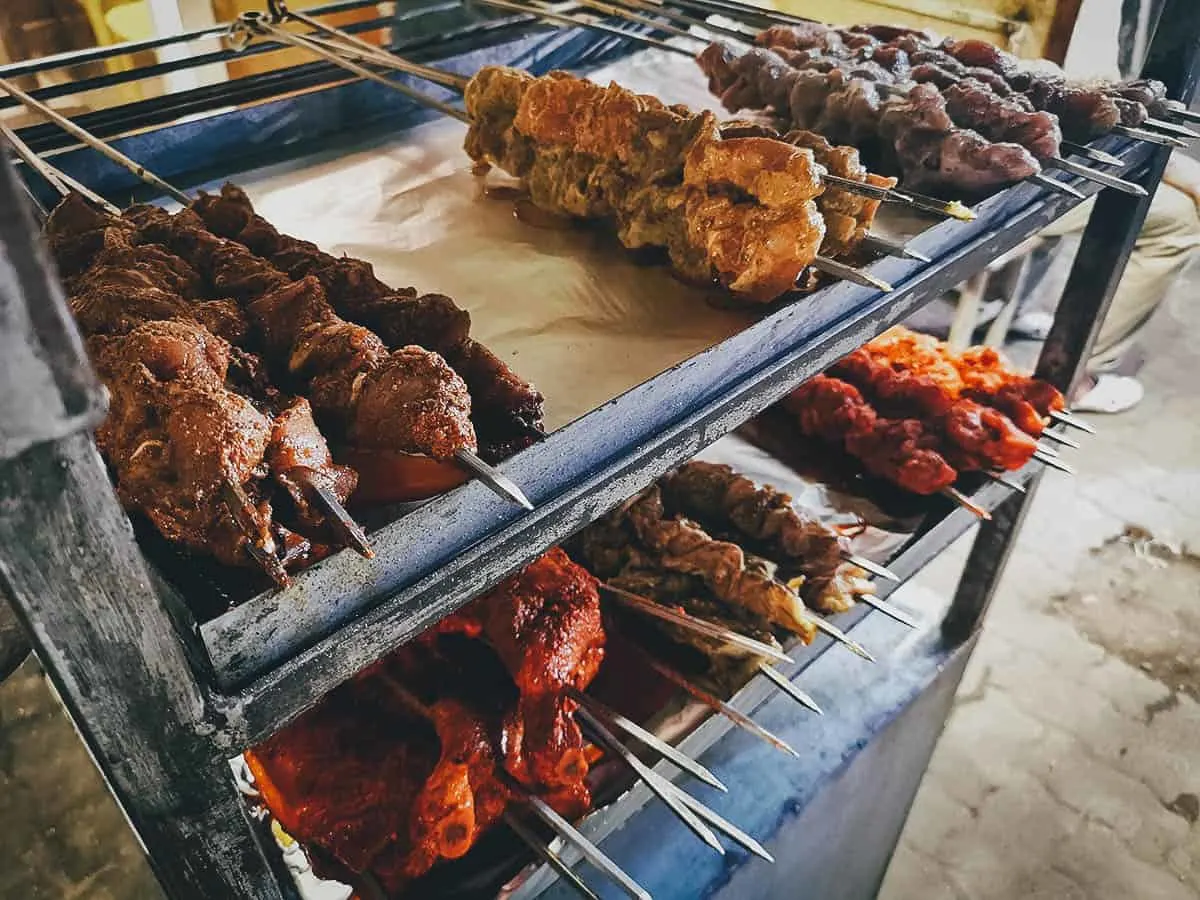
24. Bombay Duck Rava Fry
Bombay duck is a misnomer. It describes a popular Mumbai dish that isn’t made with fowl, but fish. Bombay duck refers to Harpadon nehereus, a species of lizardfish (no, it isn’t a reptile either) that thrives in the tropical waters of the Indo-Pacific.
Also known as bombil, Bombay duck is used in many dishes but one of the tastiest has to be Bombay duck rava fry. It’s made by coating bombil fillets in a spiced rava (semolina) and rice flour mixture before shallow-frying them till crispy and golden brown. Crunchy on the outside but soft and buttery on the inside, it’s absolutely delicious.
Pictured below is a Bombay duck thali (full plate meal) with rice, chapati, chutney, and solkhadi, which is a type of curry drink made with coconut milk and kokum fruit.
RECIPE: Bombay duck fry
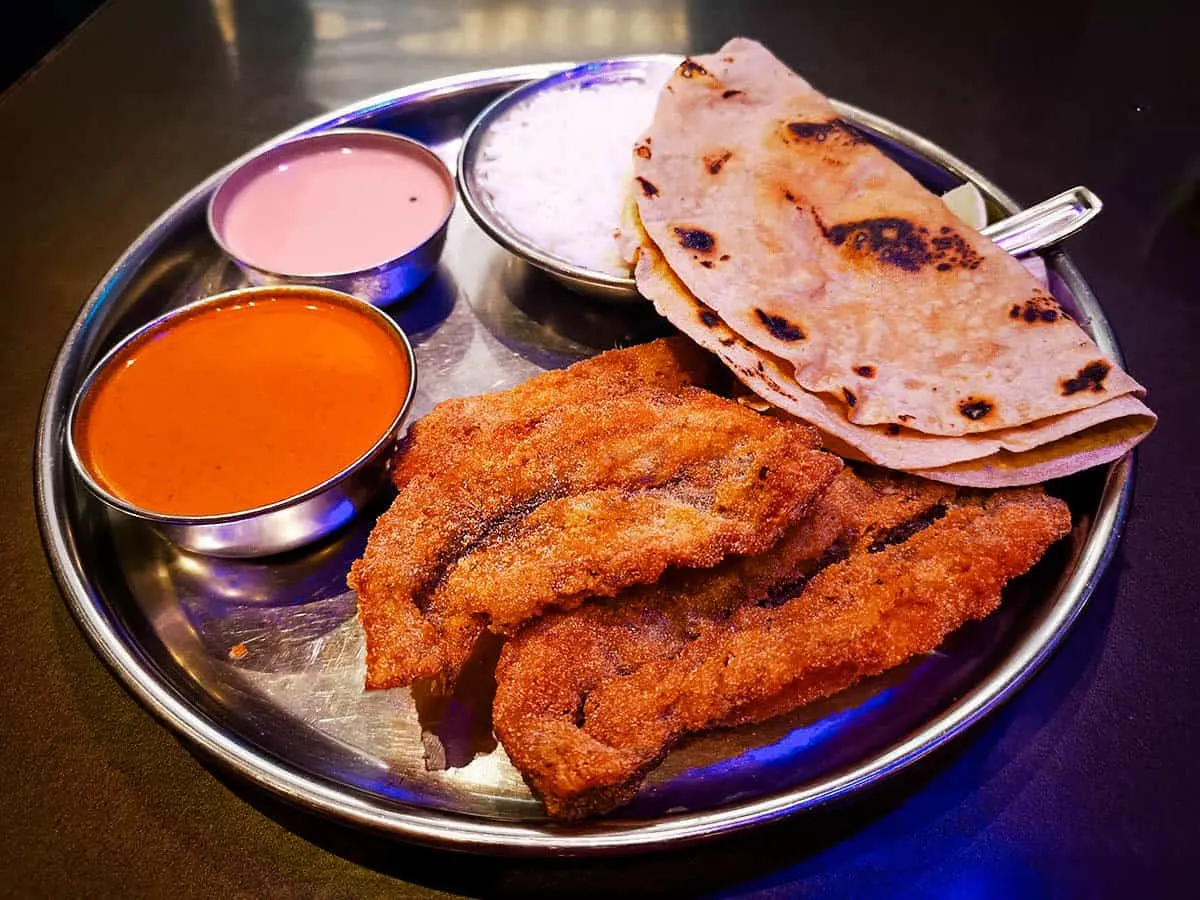
25. Mishti Doi
Mishti doi is a traditional Bengali dessert made with sweetened fermented caramelized dahi (yogurt). Mishti in Bengali means “sweet” and doi means “curd”, so mishti doi literally translates to “sweet curd”. In Hindi, it’s known as meetha dahi.
To prepare, milk is boiled until it’s slightly thickened. It’s then sweetened with brown sugar or jaggery and allowed to set and ferment overnight with curd. No flavorings are usually added though it’s common to sneak in just a pinch of cardamom for fragrance.
Mishti doi is always made in earthenware bowls because the porous walls facilitate the evaporation of water and further thickens the yogurt. It also allows for the ideal temperature for the growth of the culture.
RECIPE: Mishti doi
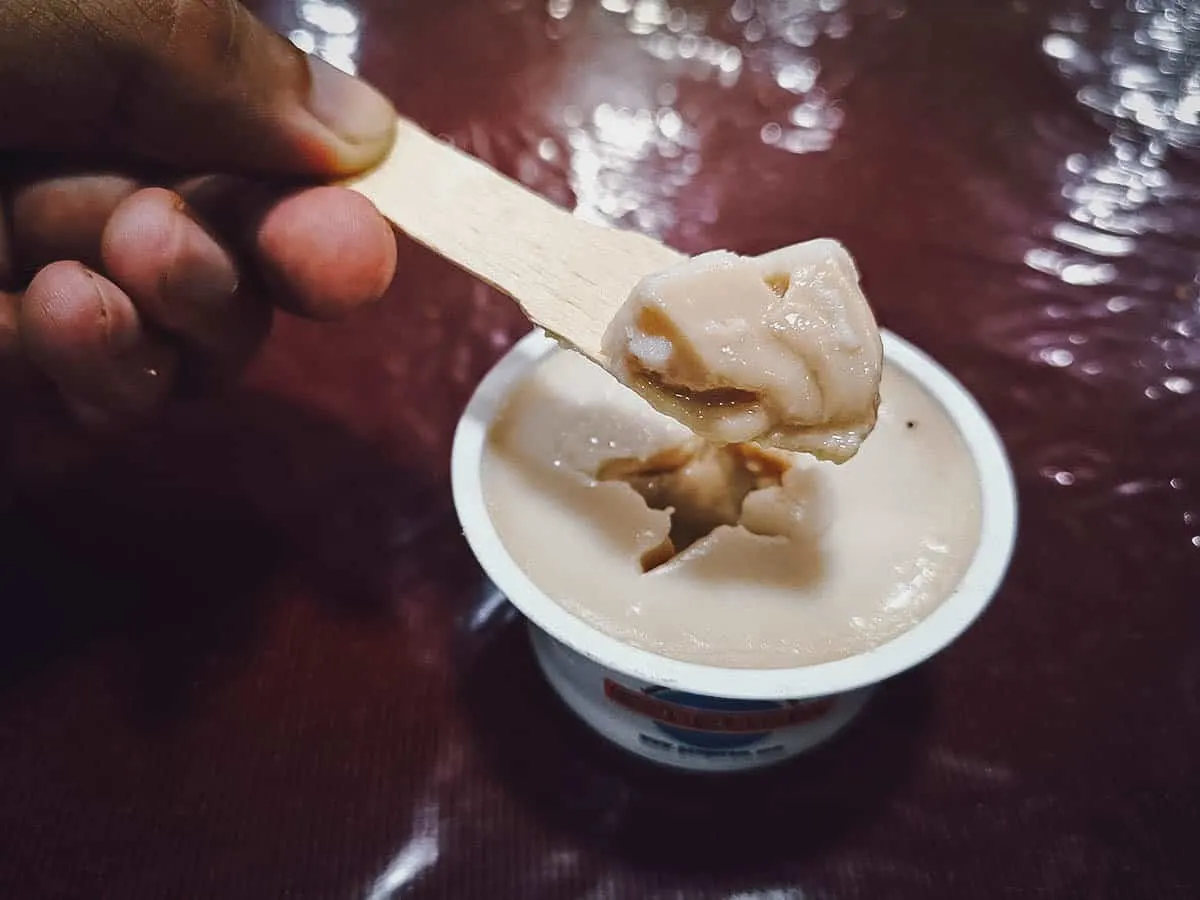
26. Jalebi
Jalebi is one of the most common Indian street food desserts. It’s a hugely popular snack that’s enjoyed in many parts of India and across South Asia, the Middle East, and North Africa.
This bright orange snack is made from a fermented batter made with all-purpose flour and besan flour. The batter is poured in concentric circles into hot oil and deep-fried. The fried spirals are then soaked in a sugar syrup mixture before serving.
Jalebi has a crunchy crystalized sugary coating that’s very sweet. It’s eaten on its own as a snack or for dessert but it can be paired with savory dishes as well. In Indore, it’s commonly eaten with poha for breakfast or as a street food dish.
RECIPE: Jalebi
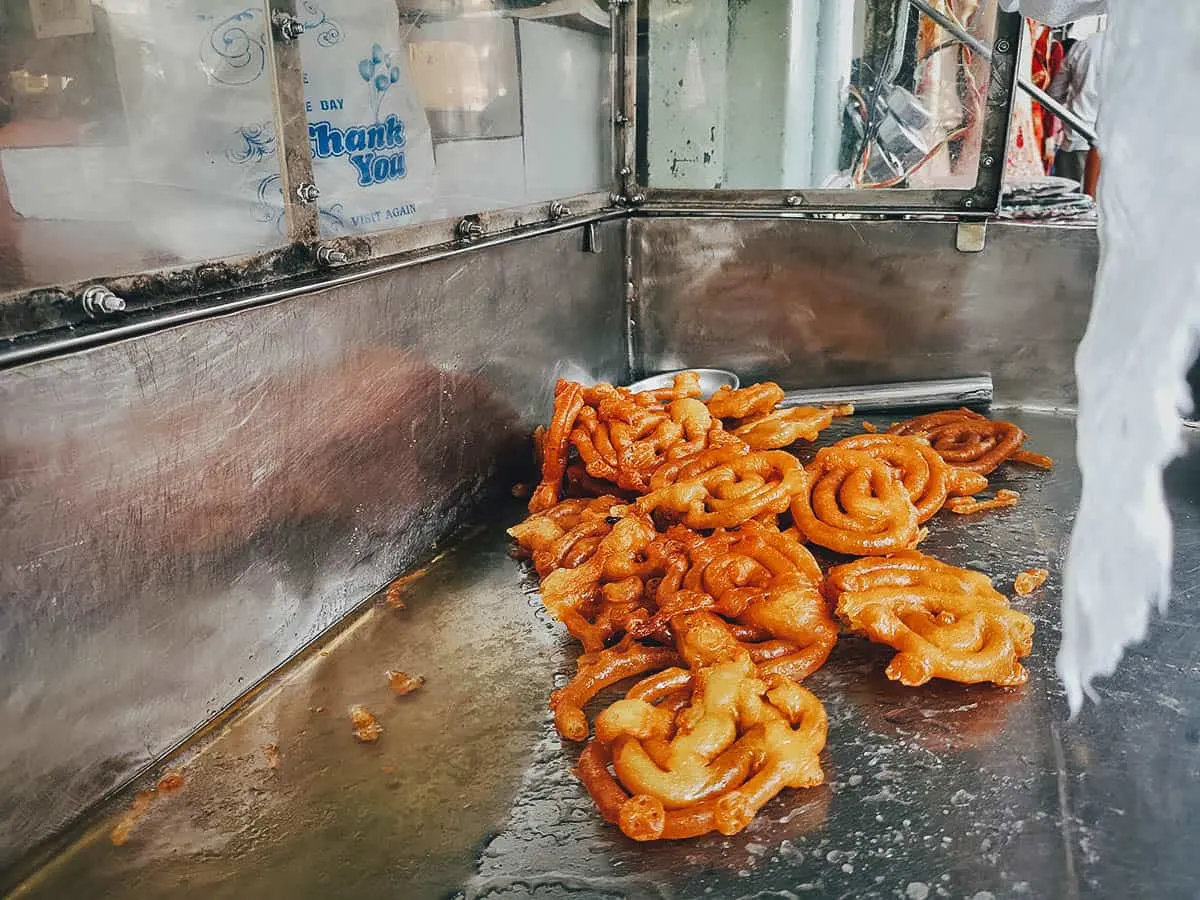
27. Doodhpak
Doodhpak refers to this delicious Indian dessert pudding from Gujarat. It’s made with milk and basmati rice flavored with sugar, saffron, cardamom, raisins, pistachios, and almonds. It’s a rich and creamy dessert with great texture from the nuts and just the right amount of sweetness.
RECIPE: Doodhpak
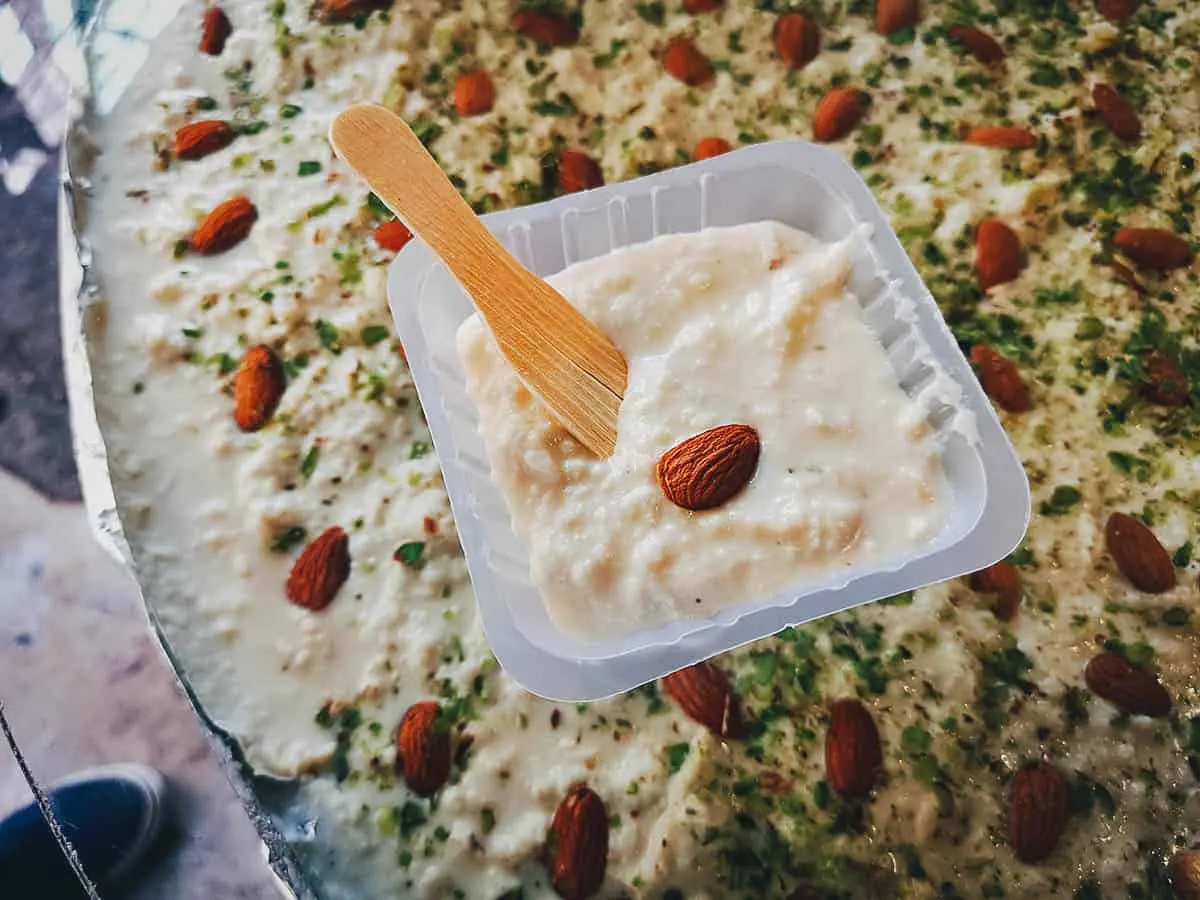
28. Kulfi
Kulfi refers to a family of frozen Indian desserts. It’s often described as traditional Indian ice cream though its consistency is denser, like frozen ice cream bars. It’s popular throughout India and the rest of the subcontinent.
Kulfi is made with milk and sugar flavored with fruits, nuts, and spices. To prepare, the sweetened and flavored milk is slowly heated and thickened before being quickly frozen in tightly sealed molds. This fast freezing process produces a smooth ice cream devoid of ice crystals. Kulfi comes in many flavors but some of the most traditional include mango (pictured below), pistachio, rose, cardamom, and saffron.
Because kulfi is denser than western ice cream, it takes longer to melt which is ideal for India’s scorching climate. This mango kulfi was delicious and refreshing and something you’ll probably look for everyday in India.
RECIPE: Kulfi
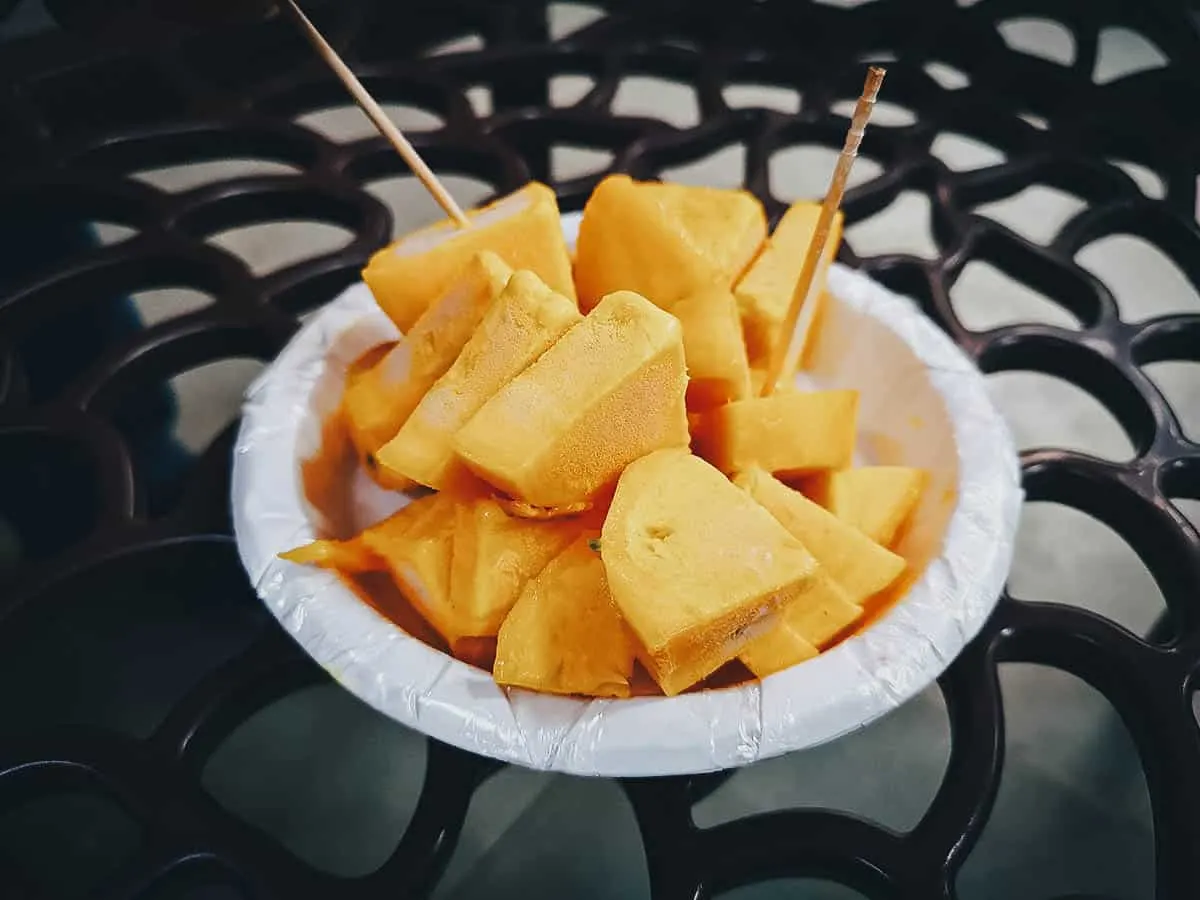
I went on a street food tour in Delhi and our last stop was this iconic stall famous for their stuffed kulfi. It refers to kulfi made from fruit pulp which is then stuffed back into the fruit before being frozen and set. How they manage to do that I have no idea.
This is what my mango kulfi looked like before it was sliced up and served to me. You can choose from four stuffed kulfi flavors – mango, apple, orange, and pomegranate. I wish I could have tried all four.
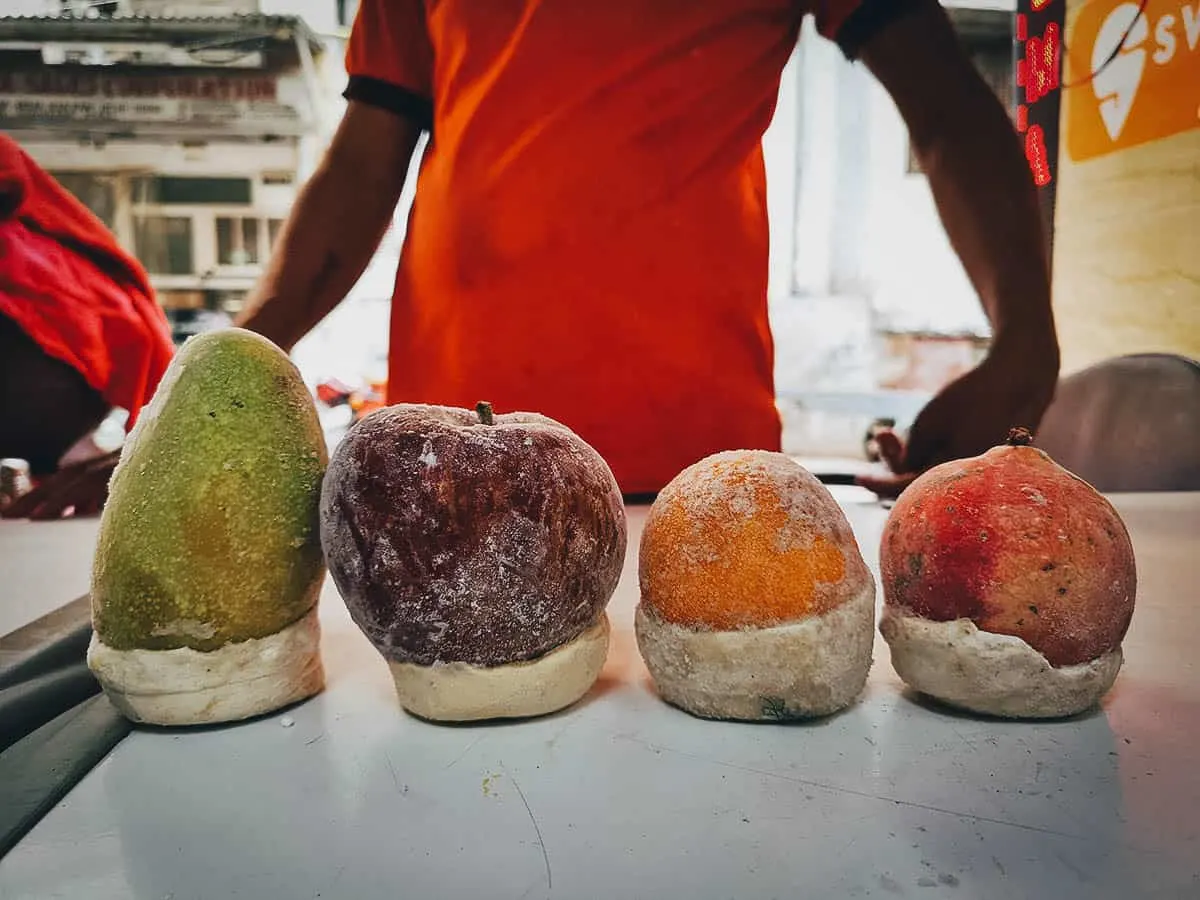
29. Sancha Ice Cream
Sancha ice cream is a type of Indian ice cream that gets its name from the vessel used to make it – a sancha. The sancha is a hand-powered device that was invented in the mid-19th century to allow people to make ice cream at home.
This heritage sancha ice cream shop was the last stop on our Mumbai street food tour. We got two flavors – Alphonso mango and custard apple. Both were delicious. Unlike kulfi which is frozen, sancha ice cream is closer in consistency to a creamy western-style ice cream.
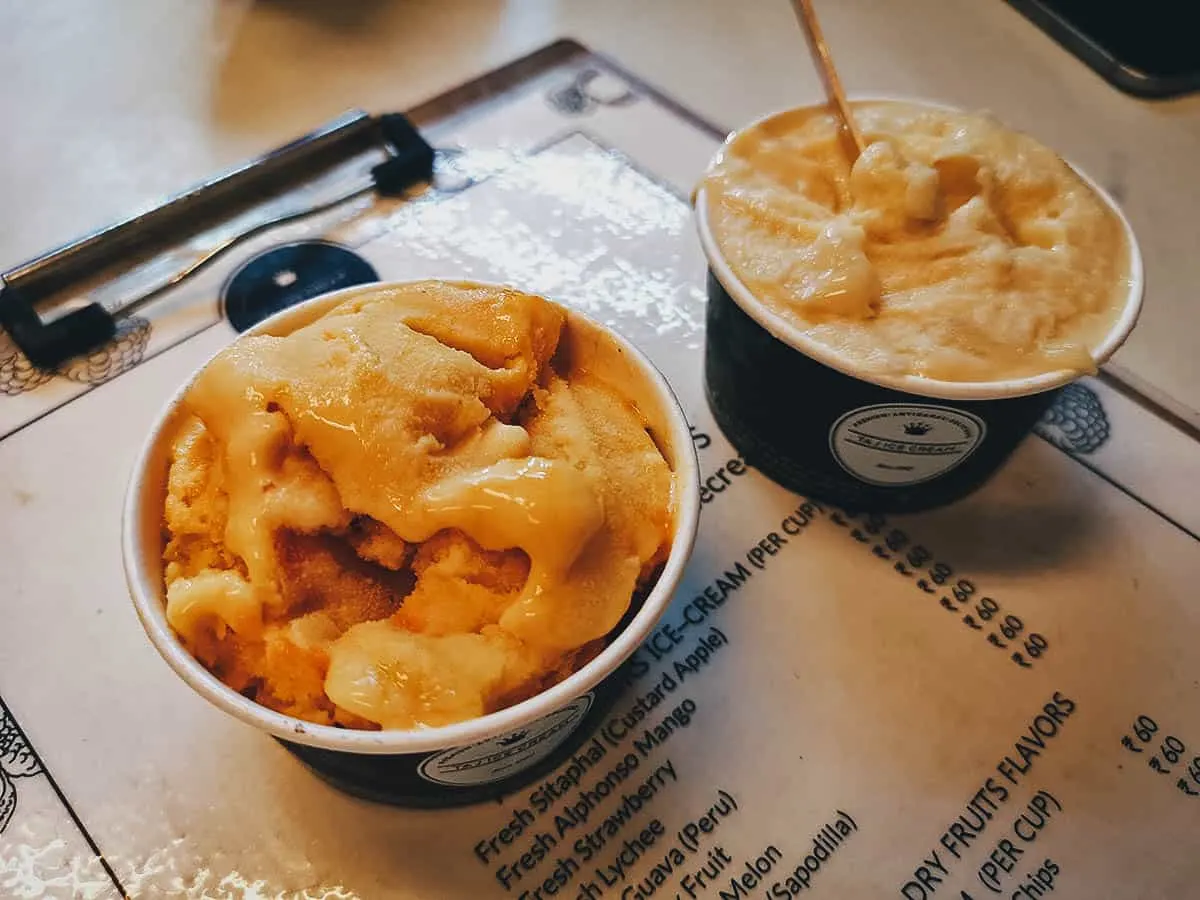
This bucket filled with rock salt and ice forms part of the sancha. The other part is a metal cylinder that goes into this bucket. The cylinder is filled with ice cream which is hand-churned as it freezes to keep ice crystals from forming.
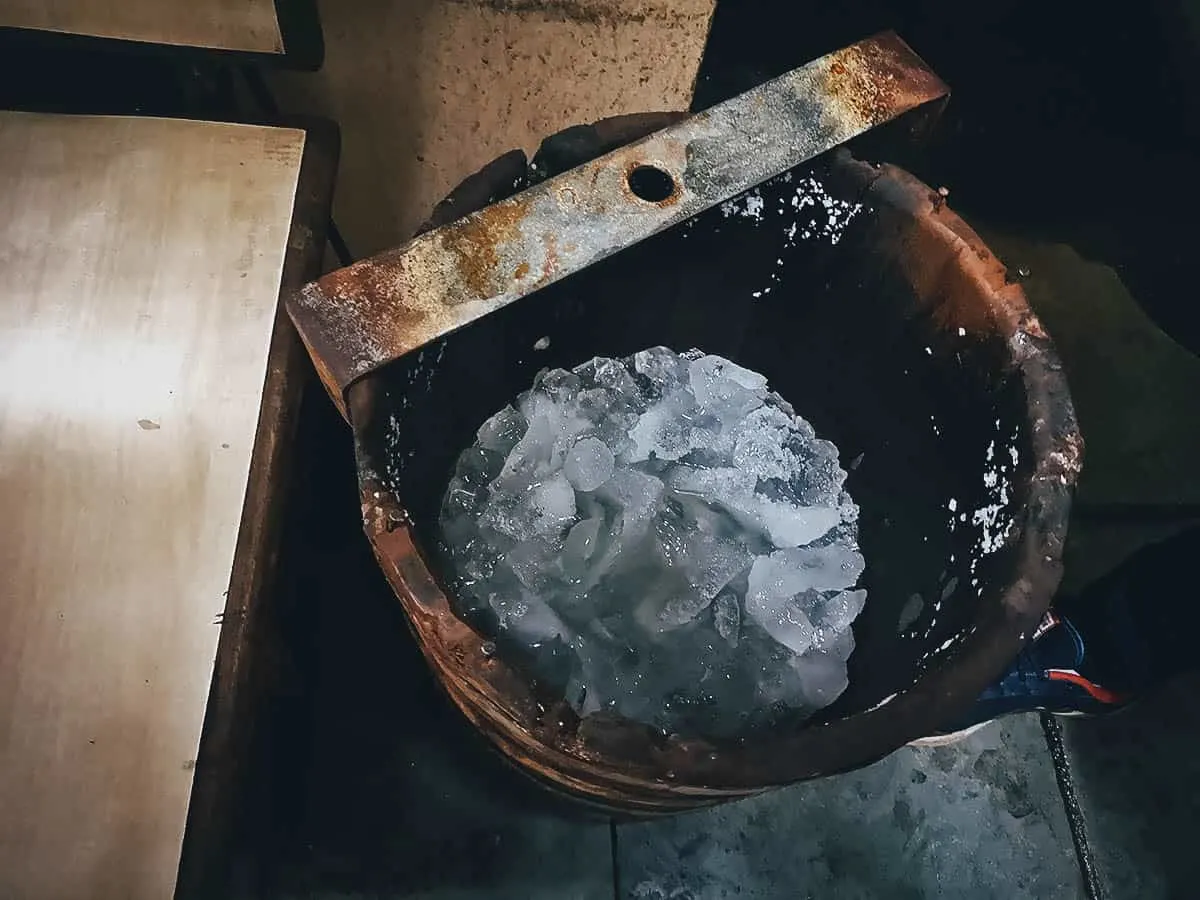
30. Paan
Paan (or pan) isn’t really a dish, but more like a digestive or mouth freshener. It consists of betel leaf filled with chopped betel (areca) nuts and slaked lime to which a plethora of other ingredients like rose petal preserves, seeds, nuts, banana syrup, coconut shavings, and spices may be added. It’s chewed thoroughly before being spit out or swallowed.
Paan originated in India but it’s widely consumed throughout South Asia, Southeast Asia, and Taiwan. In India, it can be made with chewing tobacco or flavored with an endless array of ingredients like chocolate, mango, cola, or pineapple. A fiery version called “flaming paan” even went viral on social media. It’s literally a fire ball that explodes with flavor on your taste buds.
As colorful and interesting as paan is, it isn’t without its controversies. It acts like a caffeine-like stimulant and is known to be addictive. It can cause tooth and gum decay and the consumption of areca nut has been linked to certain cancers. On top of that, it’s unsightly.
Chewing paan turns your saliva red which can be an eyesore when spat out onto public sidewalks. To combat this, the government has taken measures to ban or limit the sale of paan, and to issue fines for spitting out paan juice in public.
RECIPE: Paan chaat
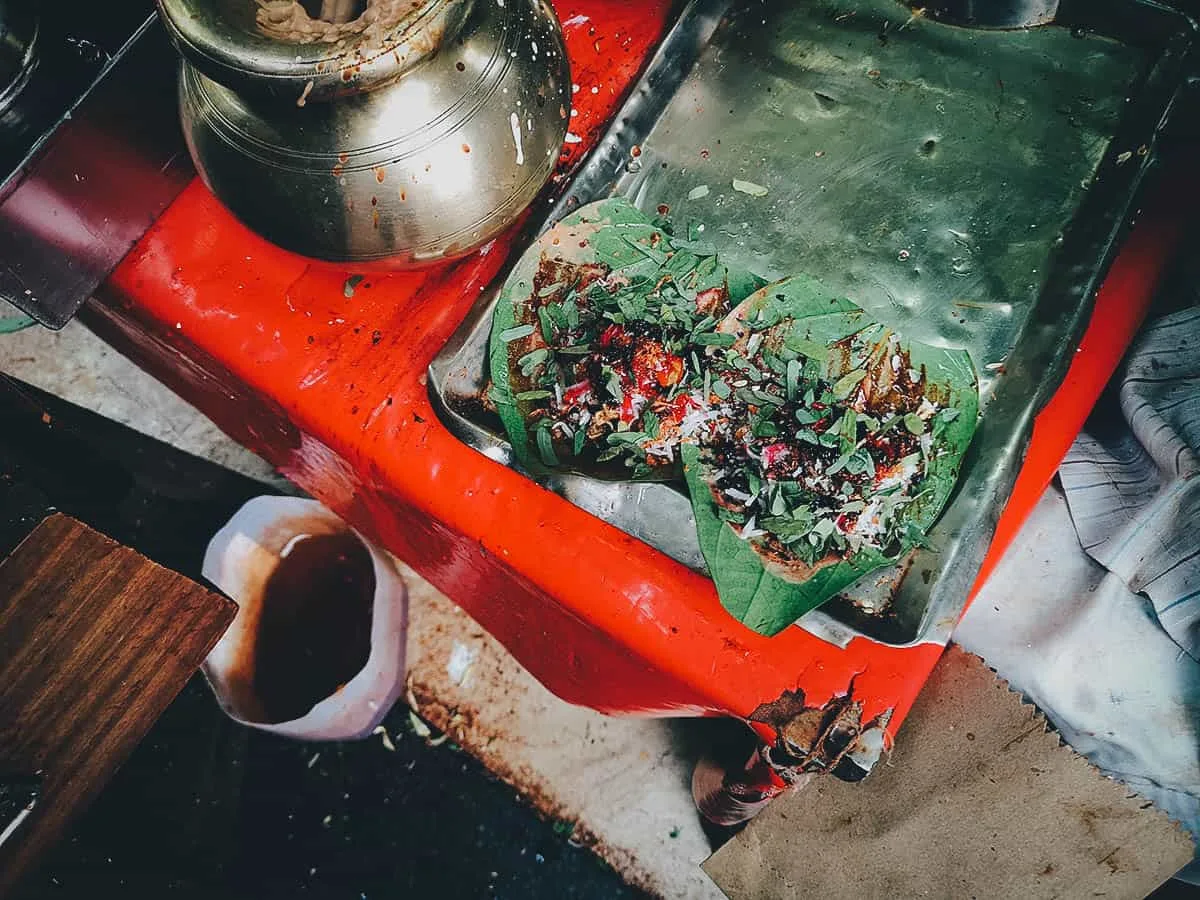
POPULAR CITIES FOR STREET FOOD IN INDIA
Street food is popular all throughout India but some cities are better known for it than others. Listed below are five of the most popular cities for street food in India.
1. Delhi
It’s no surprise that Delhi tops this list considering that it may indeed be the city that first popularized street food in India. Just spend a day exploring the labyrinthine alleyways of Chandni Chowk and you’ll be mesmerized by its dizzying array of street food!
I went on a street food tour in Old Delhi and got to experience some of the city’s tastiest examples of jalebi, pani puri, paratha, kachori, kulfi, and more. Delhi has a reputation for having some of the best food in India and its street food is no exception.
2. Kolkata
Like Delhi, Kolkata is often cited for being one of the best cities for street food in India. It’s the birthplace of the kathi roll and home to many delicious street food dishes like jhalmuri, puchkas, Mughlai parathas, and the Kolkata fish fry.
I went on a food tour in Kolkata and got to experience a plethora of street food dishes along with other tasty examples of Bengali cuisine. My guide even took me to a few heritage stalls that have been open for well over a hundred years!
3. Mumbai
Mumbai was my favorite city in India and much of that has to do with the food. Surrounded by the Arabian Sea, it’s home to fantastic seafood dishes like garlic butter crab and Bombay duck, not to mention a wealth of tasty street foods like vada pav, pav bhaji, bhel puri, aloo tikki, dosas, and the Bombay sandwich.
4. Lucknow
Lucknow is one of the best cities in India to visit for non-vegetarian food. It’s known for its Nawabi and Awadhi dishes, none more beloved perhaps than the tunde ke kabab, which is a type of kebab made with finely minced buffalo meat. Other popular street foods in Lucknow include chaat, aloo tikki, lassi, and kulfi.
5. Indore
Indore is often called the food capital of central India, and with good reason. It’s famous for its Indori poha with jalebi and other tasty street food dishes like dahi vadas, bhutte ka kees, khatta samosas, and kulfi falooda.
FINAL THOUGHTS ON INDIAN STREET FOOD
30 street food dishes may seem like a lot in many countries but not in India. In this vast country where street food is life, this list of 30 is just the very tip of the iceberg. But I do hope it gives you enough to go on and gets you even more excited to experience the street food in India.
As with all our food guides, this Indian street food guide is a perennial work-in-progress that will continue to grow and get better after each return visit to India. If you know Indian street food well and have any suggestions for us, then do let us know in the comments below. We love getting suggestions from locals and learning about new dishes.
Thanks for reading and have an amazing (and safe) time exploring the street food in India!
Disclosure
Some of the links in this Indian street food guide are affiliate links. We’ll get a small commission if you make a purchase at no added cost to you. As always, we only recommend products and services that we use ourselves and firmly believe in. We really appreciate your support as it helps us make more of these free travel guides. Thank you!
Cover photo by Yarygin via Deposit Photos

